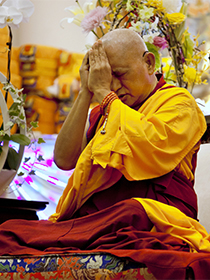- Home
- FPMT Homepage

Foundation for the Preservation of the Mahayana Tradition
The FPMT is an organization devoted to preserving and spreading Mahayana Buddhism worldwide by creating opportunities to listen, reflect, meditate, practice and actualize the unmistaken teachings of the Buddha and based on that experience spreading the Dharma to sentient beings. We provide integrated education through which people’s minds and hearts can be transformed into their highest potential for the benefit of others, inspired by an attitude of universal responsibility and service. We are committed to creating harmonious environments and helping all beings develop their full potential of infinite wisdom and compassion. Our organization is based on the Buddhist tradition of Lama Tsongkhapa of Tibet as taught to us by our founders Lama Thubten Yeshe and Lama Thubten Zopa Rinpoche.
- Willkommen
Die Stiftung zur Erhaltung der Mahayana Tradition (FPMT) ist eine Organisation, die sich weltweit für die Erhaltung und Verbreitung des Mahayana-Buddhismus einsetzt, indem sie Möglichkeiten schafft, den makellosen Lehren des Buddha zuzuhören, über sie zur reflektieren und zu meditieren und auf der Grundlage dieser Erfahrung das Dharma unter den Lebewesen zu verbreiten.
Wir bieten integrierte Schulungswege an, durch denen der Geist und das Herz der Menschen in ihr höchstes Potential verwandelt werden zum Wohl der anderen – inspiriert durch eine Haltung der universellen Verantwortung und dem Wunsch zu dienen. Wir haben uns verpflichtet, harmonische Umgebungen zu schaffen und allen Wesen zu helfen, ihr volles Potenzial unendlicher Weisheit und grenzenlosen Mitgefühls zu verwirklichen.
Unsere Organisation basiert auf der buddhistischen Tradition von Lama Tsongkhapa von Tibet, so wie sie uns von unseren Gründern Lama Thubten Yeshe und Lama Thubten Zopa Rinpoche gelehrt wird.
- Bienvenidos
La Fundación para la preservación de la tradición Mahayana (FPMT) es una organización que se dedica a preservar y difundir el budismo Mahayana en todo el mundo, creando oportunidades para escuchar, reflexionar, meditar, practicar y actualizar las enseñanzas inconfundibles de Buda y en base a esa experiencia difundir el Dharma a los seres.
Proporcionamos una educación integrada a través de la cual las mentes y los corazones de las personas se pueden transformar en su mayor potencial para el beneficio de los demás, inspirados por una actitud de responsabilidad y servicio universales. Estamos comprometidos a crear ambientes armoniosos y ayudar a todos los seres a desarrollar todo su potencial de infinita sabiduría y compasión.
Nuestra organización se basa en la tradición budista de Lama Tsongkhapa del Tíbet como nos lo enseñaron nuestros fundadores Lama Thubten Yeshe y Lama Zopa Rinpoche.
A continuación puede ver una lista de los centros y sus páginas web en su lengua preferida.
- Bienvenue
L’organisation de la FPMT a pour vocation la préservation et la diffusion du bouddhisme du mahayana dans le monde entier. Elle offre l’opportunité d’écouter, de réfléchir, de méditer, de pratiquer et de réaliser les enseignements excellents du Bouddha, pour ensuite transmettre le Dharma à tous les êtres. Nous proposons une formation intégrée grâce à laquelle le cœur et l’esprit de chacun peuvent accomplir leur potentiel le plus élevé pour le bien d’autrui, inspirés par le sens du service et une responsabilité universelle. Nous nous engageons à créer un environnement harmonieux et à aider tous les êtres à épanouir leur potentiel illimité de compassion et de sagesse. Notre organisation s’appuie sur la tradition guéloukpa de Lama Tsongkhapa du Tibet, telle qu’elle a été enseignée par nos fondateurs Lama Thoubtèn Yéshé et Lama Zopa Rinpoché.
Visitez le site de notre Editions Mahayana pour les traductions, conseils et nouvelles du Bureau international en français.
Voici une liste de centres et de leurs sites dans votre langue préférée
- Benvenuto
L’FPMT è un organizzazione il cui scopo è preservare e diffondere il Buddhismo Mahayana nel mondo, creando occasioni di ascolto, riflessione, meditazione e pratica dei perfetti insegnamenti del Buddha, al fine di attualizzare e diffondere il Dharma fra tutti gli esseri senzienti.
Offriamo un’educazione integrata, che può trasformare la mente e i cuori delle persone nel loro massimo potenziale, per il beneficio di tutti gli esseri, ispirati da un’attitudine di responsabilità universale e di servizio.
Il nostro obiettivo è quello di creare contesti armoniosi e aiutare tutti gli esseri a sviluppare in modo completo le proprie potenzialità di infinita saggezza e compassione.
La nostra organizzazione si basa sulla tradizione buddhista di Lama Tsongkhapa del Tibet, così come ci è stata insegnata dai nostri fondatori Lama Thubten Yeshe e Lama Zopa Rinpoche.
Di seguito potete trovare un elenco dei centri e dei loro siti nella lingua da voi prescelta.
- 欢迎 / 歡迎
简体中文
“护持大乘法脉基金会”( 英文简称:FPMT。全名:Foundation for the Preservation of the Mahayana Tradition) 是一个致力于护持和弘扬大乘佛法的国际佛教组织。我们提供听闻,思维,禅修,修行和实证佛陀无误教法的机会,以便让一切众生都能够享受佛法的指引和滋润。
我们全力创造和谐融洽的环境, 为人们提供解行并重的完整佛法教育,以便启发内在的环宇悲心及责任心,并开发内心所蕴藏的巨大潜能 — 无限的智慧与悲心 — 以便利益和服务一切有情。
FPMT的创办人是图腾耶喜喇嘛和喇嘛梭巴仁波切。我们所修习的是由两位上师所教导的,西藏喀巴大师的佛法传承。
繁體中文
護持大乘法脈基金會”( 英文簡稱:FPMT。全名:Found
ation for the Preservation of the Mahayana Tradition ) 是一個致力於護持和弘揚大乘佛法的國際佛教組織。我們提供聽聞, 思維,禪修,修行和實證佛陀無誤教法的機會,以便讓一切眾生都能 夠享受佛法的指引和滋潤。 我們全力創造和諧融洽的環境,
為人們提供解行並重的完整佛法教育,以便啟發內在的環宇悲心及責 任心,並開發內心所蘊藏的巨大潛能 — 無限的智慧與悲心 – – 以便利益和服務一切有情。 FPMT的創辦人是圖騰耶喜喇嘛和喇嘛梭巴仁波切。
我們所修習的是由兩位上師所教導的,西藏喀巴大師的佛法傳承。 察看道场信息:
- FPMT Homepage
- News/Media
-
- Study & Practice
-
-
- About FPMT Education Services
- Latest News
- Programs
- New to Buddhism?
- Buddhist Mind Science: Activating Your Potential
- Heart Advice for Death and Dying
- Discovering Buddhism
- Living in the Path
- Exploring Buddhism
- FPMT Basic Program
- FPMT Masters Program
- FPMT In-Depth Meditation Training
- Maitripa College
- Lotsawa Rinchen Zangpo Translator Program
- Universal Education for Compassion & Wisdom
- Online Learning Center
-
- Prayers & Practice Materials
- Overview of Prayers & Practices
- Full Catalogue of Prayers & Practice Materials
- Explore Popular Topics
- Benefiting Animals
- Chenrezig Resources
- Death & Dying Resources
- Lama Chopa (Guru Puja)
- Lama Zopa Rinpoche: Compendium of Precious Instructions
- Lama Zopa Rinpoche: Life Practice Advice
- Lama Zopa Rinpoche Practice Series
- Lamrim Resources
- Mantras
- Prayer Book Updates
- Purification Practices
- Sutras
- Thought Transformation (Lojong)
- Audio Materials
- Dharma Dates - Tibetan Calendar
- Translation Services
- Publishing Services
- Ways to Offer Support
- Prayers & Practice Materials
-
- Teachings and Advice
- Find Teachings and Advice
- Lama Zopa Rinpoche Advice Page
- Lama Zopa Rinpoche: Compendium of Precious Instructions
- Lama Zopa Rinpoche Video Teachings
- ༧སྐྱབས་རྗེ་བཟོད་པ་རིན་པོ་ཆེ་མཆོག་ནས་སྩལ་བའི་བཀའ་སློབ་བརྙན་འཕྲིན།
- Podcasts
- Lama Yeshe Wisdom Archive
- Buddhism FAQ
- Dharma for Young People
- Resources on Holy Objects
- Teachings and Advice
-
-
*If a menu item has a submenu clicking once will expand the menu clicking twice will open the page.
-
-
- Centers
-
- Teachers
-
- Projects
-
-
-
-
*If a menu item has a submenu clicking once will expand the menu clicking twice will open the page.
-
-
- FPMT
-
-
-
-
-
Think that everyone you meet is fulfilling all your wishes.
Lama Zopa Rinpoche
-
-
-
- Shop
-
-
-
The Foundation Store is FPMT’s online shop and features a vast selection of Buddhist study and practice materials written or recommended by our lineage gurus. These items include homestudy programs, prayers and practices in PDF or eBook format, materials for children, and other resources to support practitioners.
Items displayed in the shop are made available for Dharma practice and educational purposes, and never for the purpose of profiting from their sale. Please read FPMT Foundation Store Policy Regarding Dharma Items for more information.
-
-
Lama Zopa Rinpoche News
2
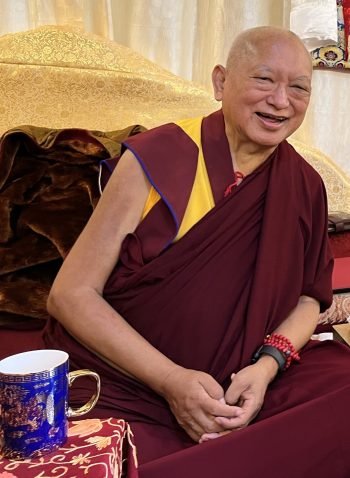
Lama Zopa Rinpoche, November 2022. Photo by Ven. Roger Kunsang.
Lama Zopa Rinpoche’s birthday is celebrated on December 3. We invite you to join the entire FPMT community as we rejoice in another year of Rinpoche’s compassionate and inspiring life, and transformative teachings.
A celebration for Rinpoche will begin at Kopan Monastery, first thing on December 3. Early in the morning a long life puja (Namgyal Tsechok) will be offered to Rinpoche. During this puja a monetary offering will be made to all of the monks and nuns in attendance on behalf of the entire FPMT organization. In the afternoon, lunch will be offered to all at Kopan including local people from the area, and November Course participants. After lunch, traditional entertainment will be offered including skits and Sherpa dance. We will share photos and more details of this joyous event after the occasion.
Please join the entire FPMT community, including students and friends around the world, in offering sincere prayers for Lama Zopa Rinpoche’s long and healthy life. (All are welcome to download Long Life Prayers for Lama Zopa Rinpoche.)
Rinpoche, on behalf of all the six-realm sentient beings who rely on you—please, please live long!
Lama Zopa Rinpoche is the spiritual director of the Foundation for the Preservation of Mahayana Tradition (FPMT), a Tibetan Buddhist organization dedicated to the transmission of the Mahayana Buddhist tradition and values worldwide through teaching, meditation, and community service.
7
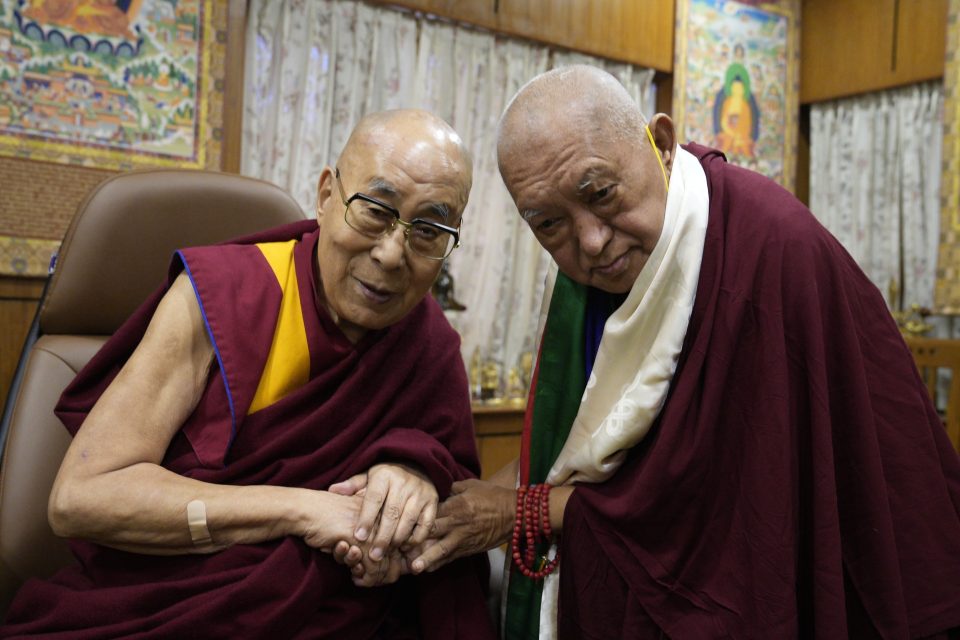
His Holiness the Dalai Lama meeting Lama Zopa Rinpoche in Dharamsala, India. November 2, 2022. Photo courtesy of the Office of His Holiness the Dalai Lama.
On November 2, 2022, Lama Zopa Rinpoche had a private audience with His Holiness the Dalai Lama in His Holiness’s residence in Dharamsala, India. Rinpoche was accompanied by Ven. Roger Kunsang, Geshe Ngawang Sangye, Ven. Tendar, and Ven. Topgye.
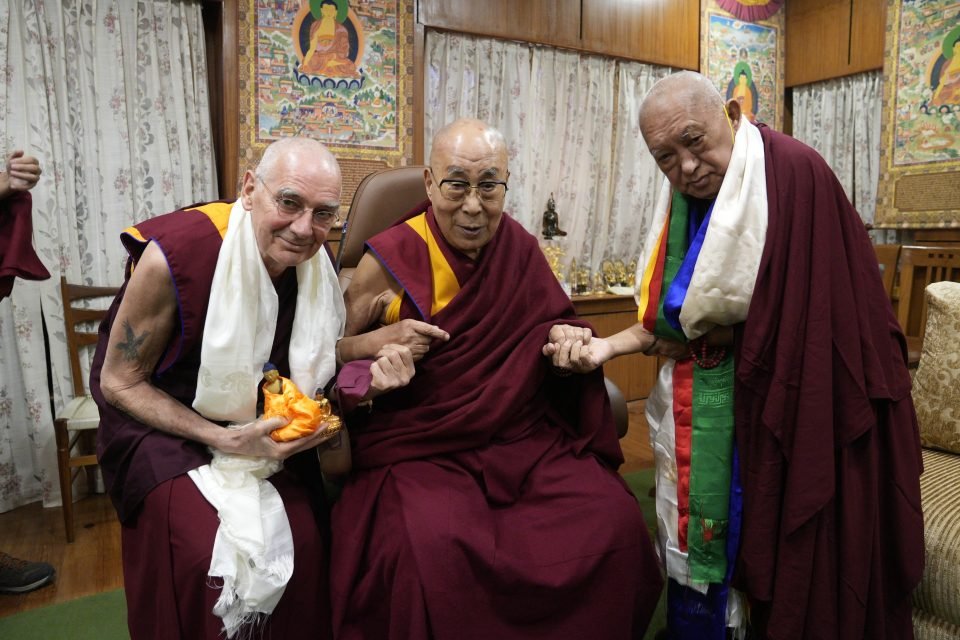
His Holiness the Dalai Lama, Lama Zopa Rinpoche, and Ven. Roger Kunsang, Dharamsala, India. November 2, 2022. Photo courtesy of the Office of His Holiness the Dalai Lama.
Ven. Roger commented about the meeting, “From the time His Holiness came into the room, His Holiness showed the aspect of being very pleased with Rinpoche and taking time with the meeting, very happy. Everything was very comfortable and easy. His Holiness was really making clear His Holiness’s appreciation for Rinpoche’s activities for the benefit of sentient beings. This was the mood of the meeting.”
Geshe Ngawang Sangye provided the following report of the meeting:
“We arrived at the meeting hall at 7:45 a.m. while His Holiness was giving a public blessing and another meeting. Just after the general public blessing His Holiness came into the hall and He was very, very happy to meet with Rinpoche. His Holiness said, “Lama Zopa, Lama Zopa, My trustworthy longtime friend.” His Holiness blessed Rinpoche several times and Rinpoche offered five colored khata offerings. After that, Roger-la and all of the attendants offered khatas. His Holiness was holding Rinpoche’s hands and thanking Rinpoche for bringing Buddha’s teaching to the West. After this Rinpoche requested His Holiness for permission to ask some questions. His Holiness replied, “Ask anything, no rush.” Rinpoche then asked some questions about the FPMT and in relation to the future of the organization. Rinpoche also asked about a future book project he is working on about the practice of compassion. His Holiness showed the aspect of being very pleased about Rinpoche spreading this practice around the world and then gave a very special meditation to be included in the book. Rinpoche requested if His Holiness would accept a long life puja offered by FPMT and His Holiness immediately accepted the long life puja.” [We will share details about this long life puja as soon as they become available.]
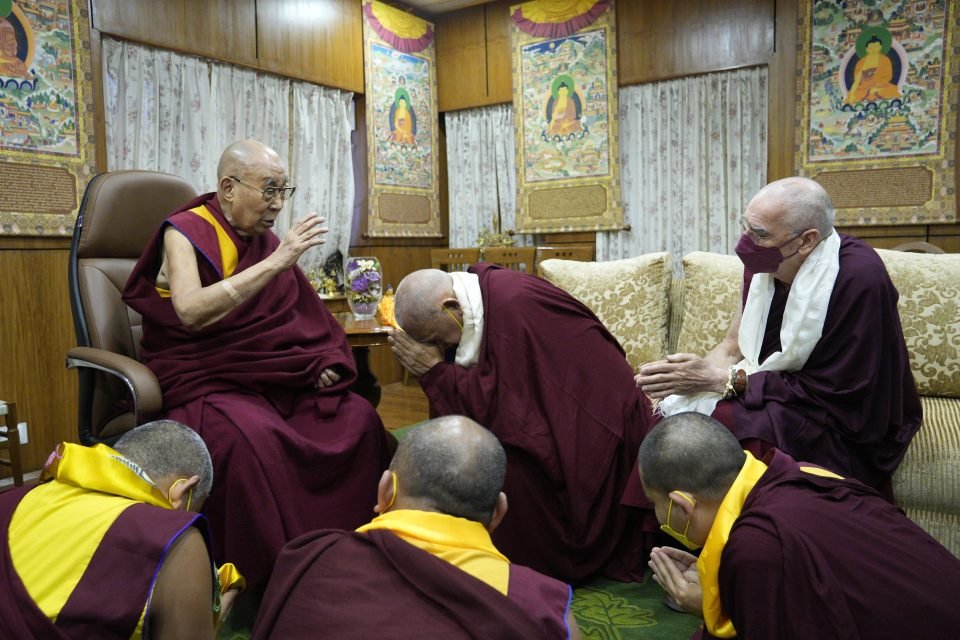
His Holiness the Dalai Lama with Lama Zopa Rinpoche, Ven. Roger Kunsang, Geshe Ngawang Sangye, Ven. Tendar and Ven. Topgye, Dharamsala, India, November 2, 2022. Photo courtesy of the Office of His Holiness the Dalai Lama.
Ven. Roger shares that the meeting was extremely positive and His Holiness offered Rinpoche a beautiful Buddha statue and strongly emphasized for Rinpoche to keep the statue with him always.
Please join the entire FPMT community in rejoicing in this most auspicious and precious meeting with His Holiness the Dalai Lama!
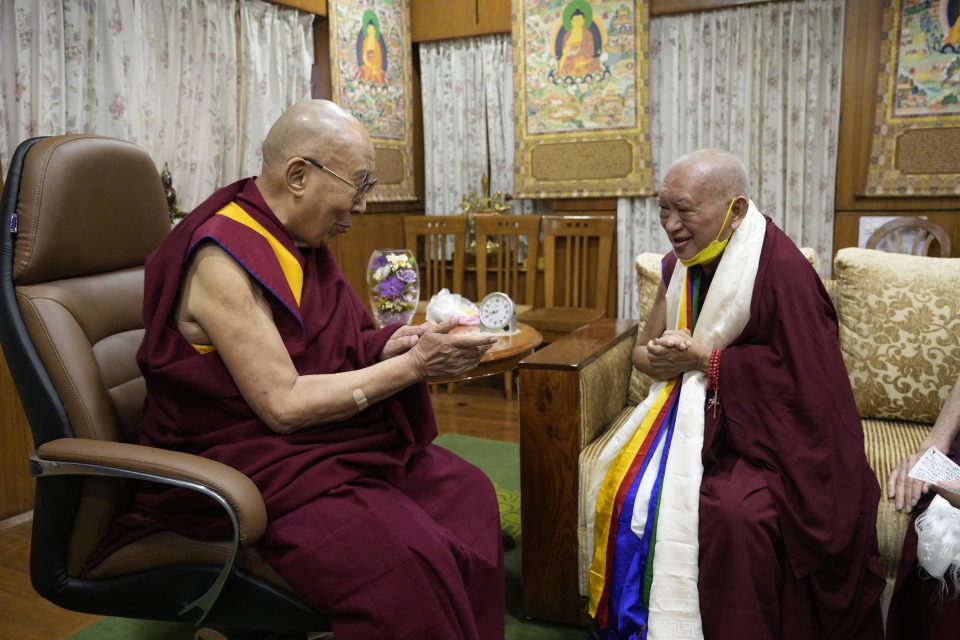
His Holiness the Dalai Lama meeting Lama Zopa Rinpoche in His Holiness’s residence in Dharamsala, India. November 2, 2022. Photo courtesy of the Office of His Holiness the Dalai Lama.
For more on His Holiness the Dalai Lama and his beneficial activities, please visit DalaiLama.com.
Lama Zopa Rinpoche is the spiritual director of the Foundation for the Preservation of Mahayana Tradition (FPMT), a Tibetan Buddhist organization dedicated to the transmission of the Mahayana Buddhist tradition and values worldwide through teaching, meditation and community service.
- Tagged: his holiness the dalai lama
20

Lama Zopa Rinpoche visiting students in Singapore, July 2022. Photo by Sengsiong Photography .
Since our last update, Lama Zopa Rinpoche offered very precious teachings at Amitabha Buddhist Centre, Singapore, in August and September. Some of these teachings have been part of the ongoing thought transformation series, and some were various talks given on particular occasions to specific groups. Following his visit in Singapore, Rinpoche traveled to India to receive teachings from Togden Rinpoche and Jhado Rinpoche at Tashi Lhunpo Monastery in Bylakuppe, India. In addition, Rinpoche engaged in a variety of auspicious activities, benefiting and blessing others with Rinpoche’s tireless compassionate action.
We invite you to read more about some of these activities below and to join us in rejoicing about how Rinpoche inspires us all to live a full and beneficial life.
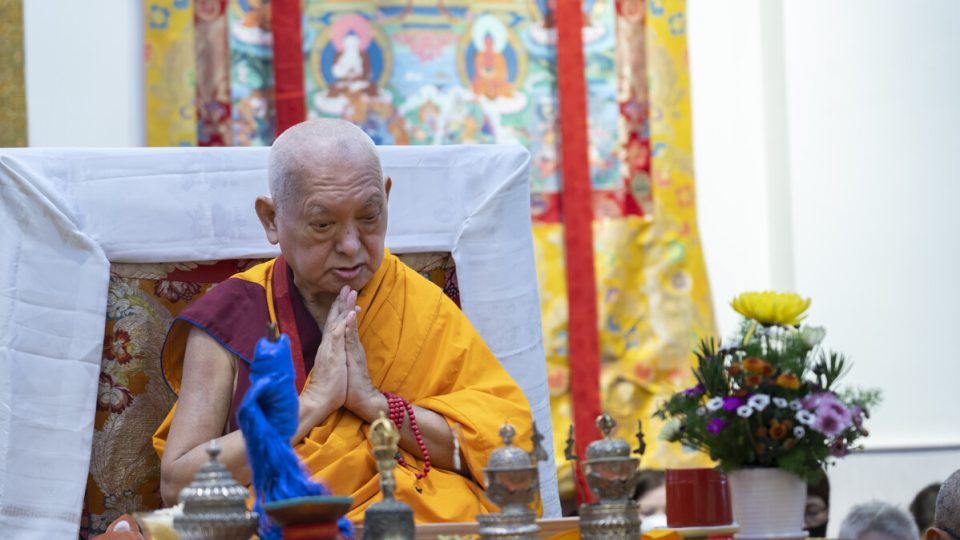
Lama Zopa Rinpoche leading a Most Secret Hayagriva tsog kong puja at Amitabha Buddhist Centre, Singapore, September 4, 2022. Photo by Ven. Lobsang Sherab.
Offering Teachings and Blessings
Rinpoche began teaching at Amitabha Buddhist Centre (ABC) in Singapore in August. While at ABC, Rinpoche offered numerous teachings on thought transformation, recorded as videos 129-137 in the ongoing thought transformation teaching series, which began in the early days of the pandemic in 2020. Other teachings included topics such as: You are So Fortunate to Meet the Lamrim Teachings, With This Human Rebirth You Can Be Happy Day and Night, The Kindness of the Buddha is Limitless Like the Sky, Advice for Generating Peace in the World, and other teachings that we are making available regularly. Rinpoche also offered Heruka Five-deity and Heruka Body Mandala initiations while at ABC and led a Most Secret Hayagriva tsog kong as well as a Lama Chopa puja for Chokhor Duchen (“Wheel-Turning Day”), on August 1. Rinpoche offered a teaching during the puja, titled The Kindness of Buddha is Limitless Like the Sky.
While in Singapore in September, Rinpoche also benefited the beings in the ocean by leading practices for them, as well as blessing many bottles of water over many days and then putting those in the ocean with Namgyalma mantra boards which purifies any being in the water. Rinpoche strongly encouraged this practice to bless those living in water around the world. This is now being done regularly in oceans and lakes in the United States, Singapore, Nepal, and other countries.
In South India, Rinpoche was joined by the Gyudmed Monastery abbot and monks at Rabgayling Tibetan Settlement, Hunsur, on October 16 to consecrate the beautiful forty-two foot stupa that Rinpoche sponsored for elders in the home at the settlement. Rinpoche offered a teaching to the local population on the benefits of reciting mantras, seeing stupas, and circumambulating holy objects.
On October 17, Rinpoche began teaching in Tibetan on lojong and offered advice to Sere Je Drati Khangtsen after paying a visit to the monastery’s newly renovated main office, and these teachings will continue in future years. The next day, October 18, Rinpoche began offering teachings in Tibetan on The Foundation of all Good Qualities by Lama Tsongkhapa at Sera Je Tsawa Khangtsen which will also continue in the future.
You can find Rinpoche’s recent teachings here: https://fpmt.org/media/streaming/teachings-of-lama-zopa-rinpoche/
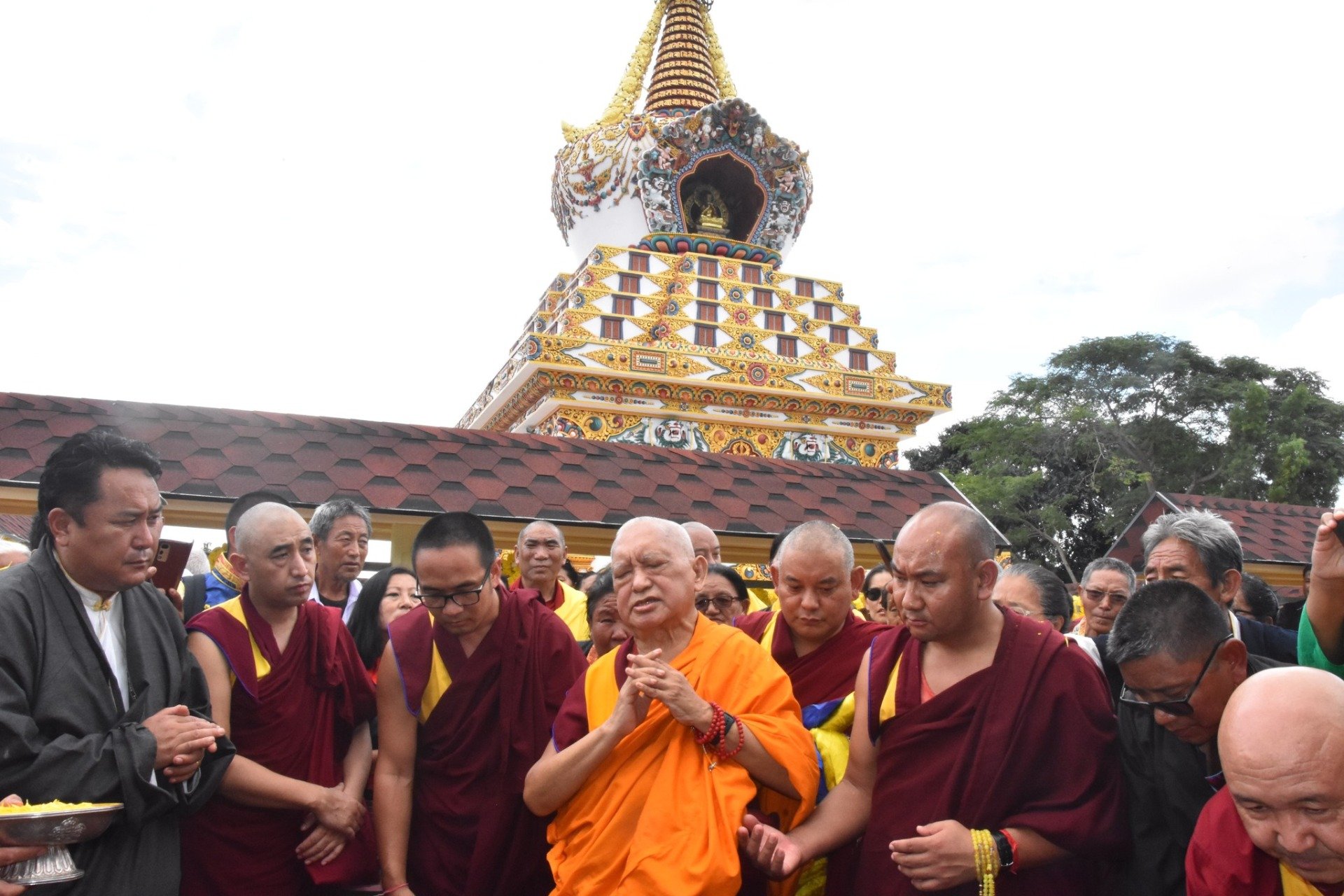
Lama Zopa Rinpoche blessing the beautiful stupa at Rabgayaling Settlement. Photo courtesy of Gyudmed Monastery Facebook page.
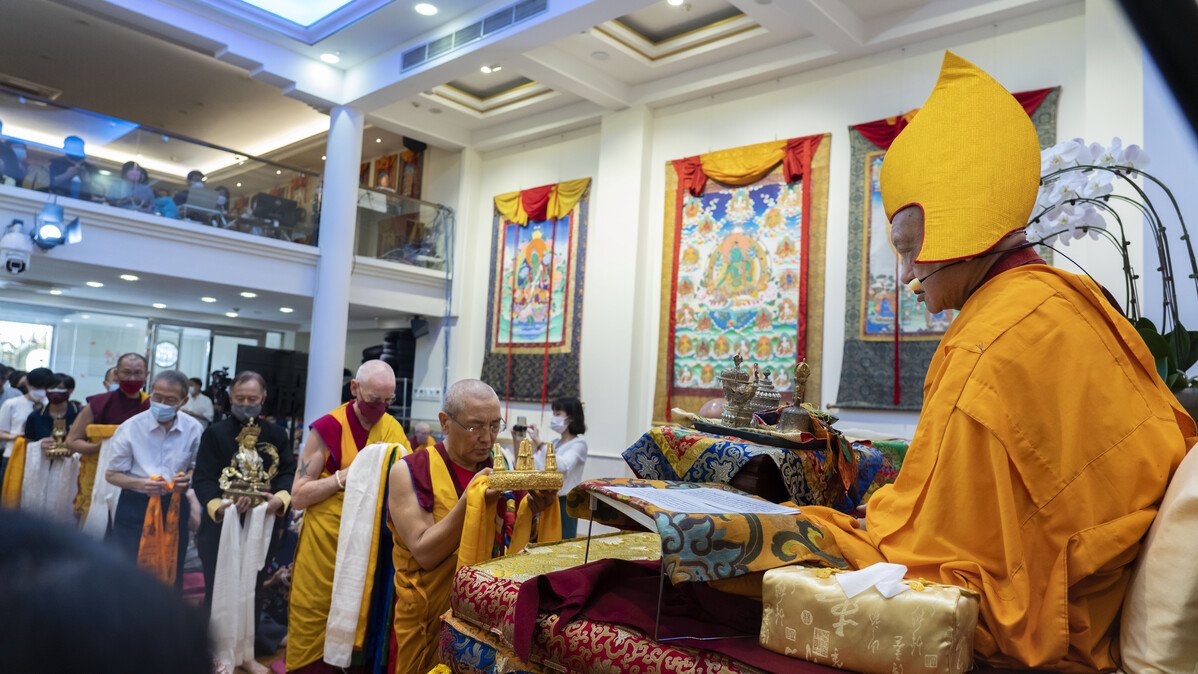
Lama Zopa Rinpoche receiving offering procession during long life puja at Amitabha Buddhist Centre, Singapore, September 11, 2022. Photo by Ven. Lobsang Sherab.
Long Life Pujas
On September 11, a few days before Rinpoche’s departure, ABC offered a beautiful long life puja for Rinpoche in thanks for the precious teachings Rinpoche offered during his three-month stay in Singapore.
On October 14, a long life puja and “Expression of Gratitude” award was offered to Lama Zopa Rinpoche at Sera Je Monastery. This special event was to honor Rinpoche for the many decades of support Rinpoche has shown to the monastery, including the 25+ year accomplishment of the Sera Je Food Fund, which is now a full endowment covering the monastery’s yearly food expenses for over 2,000 Sangha. About this event, Sera Je monk Ven. Tenzin Legtsok, shared:
“This was a rare occasion when literally all of the monks of Sera Je came together from the youngest school boys up to the ex-abbots, the most senior monks from Buxa, all the geshes, tulkus, geshe program students, and monastery staff. Among the eminent lamas in attendance were the two former abbots of Sera Je, Khensur Rinpoche Lobsang Delek and Logoan Tulku Tenzin Choesang, the ex-abbot of Namgyal Monastery, Jhado Rinpoche, the current abbot of Sera Mey Monastery, Geshe Tashi Tsering, the abbot in waiting of Gyume Monastery, Geshe Ngawang Sangye and others. There were also representatives from the local Tibetan government. Everyone was there. Just the presence of so many monks was a powerful and palpable expression of their sincere respect for Rinpoche and their deep gratitude for His support over so many years. Every monk I spoke to was very happy that the monastery had decided to organize this long life puja and award ceremony for Rinpoche. Inside, the prayer hall was filled to overflowing with geshes and senior monks in the late years of the Geshe Studies Program such that the younger monks and school boys all had to sit outside.”
You can read more about this very special long life puja and recognition of Rinpoche’s beneficial activities.
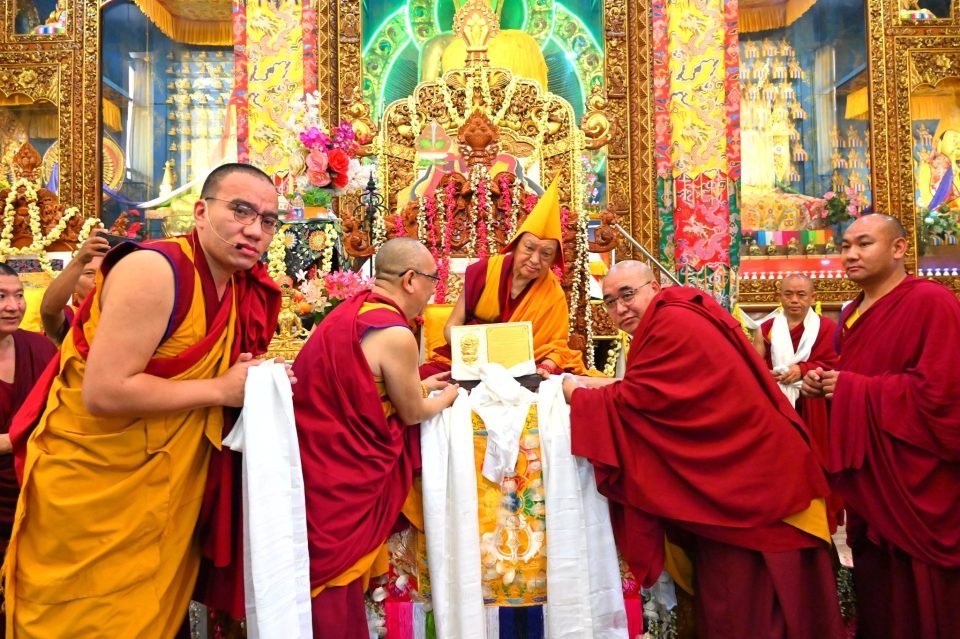
Lama Zopa Rinpoche being presented “Expression of Gratitude” award during long life puja offered by Sera Je Monastery, Bylakuppe, India, October 14, 2022. Photo Courtesy of Sera Je Monastery Facebook page.
Attending Teachings
From Singapore, Lama Zopa Rinpoche flew to India to receive teachings himself, arriving at the Bangalore airport late in the evening, September 19. Rinpoche was received at the airport by eminent Sangha from the various monasteries in South India. These dignitaries included the Abbot of Sera Je Monastic University, Geshe Tashi Tshethar, the Chant Master (Lama Umze) of Gyume Tantric Monastery, Geshe Ngawang Sangye, the Chief Administrator of Sera Je Monastery, Geshe Ngawang Jangchup, and the Secretary and Chief Mentor of Sera Je Drati Khangtsen. They all offered khatas to Rinpoche and requested blessings. Rinpoche spent about an hour at the airport talking with the monastery leaders over tea.
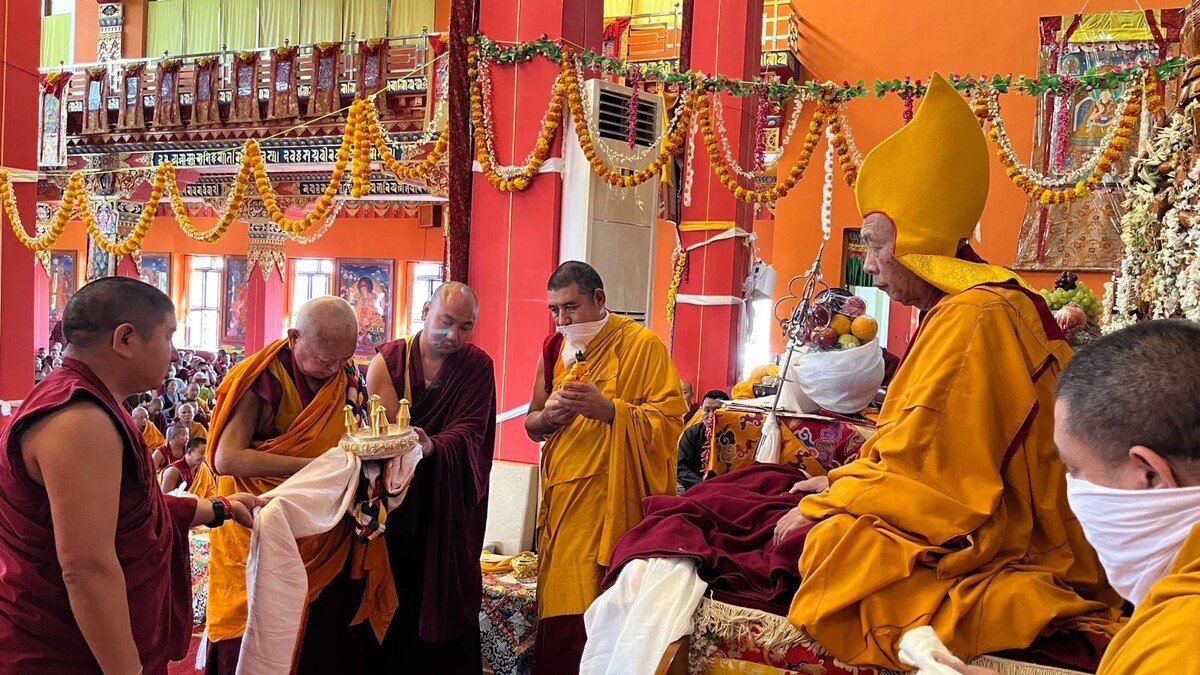
Lama Zopa Rinpoche offering the thanking mandala to Togden Rinpoche at the conclusion of teachings at Tashi Lhunpo Monastery, South India. October 12, 2022.
Beginning on September 22 through October 12, at Tashi Lhunpo Monastery, Bylakuppe, India, Lama Zopa Rinpoche, along with over 1,000 ordained Sangha, including high lamas, received a number of initiations and commentary from Togden Rinpoche. The teaching event started with the Thirteen-Deity Yamantaka, Guhyasamaja, Heruka, and Heruka Body Mandala initiations. Togden Rinpoche then offered the oral transmission and commentary of The Harbor of the Ocean of Great Bliss, a commentary of the creation and completion stages of Heruka practice in the Ghantapa lineage, that had been given by His Holiness Trijang Rinpoche, one of the tutors to His Holiness the Dalai Lama, in 1975. Togden Rinpoche received the teaching at that time directly from H.H. Trijang Rinpoche. Lama Zopa Rinpoche recently sponsored the publication of that commentary in Tibetan.
During the same time in late September, Rinpoche also attended teachings given in the afternoon by Jhado Rinpoche at Tashi Lhunpo on The Three Pith Instructions.
Lama Zopa Rinpoche was very happy to sponsor both of these precious teaching events. This included making offerings every day to the 1,000 Sangha in attendance, offering three meals a day to all, plus offering tea and bread during the teachings. Due to the kindness of two generous benefactors, Rinpoche was able to cover all the costs of sponsorship for these most valuable events.
On October 2, Rinpoche received teachings online from His Holiness the Dalai Lama, on chapter two of Dharmakirti’s Commentary on Valid Cognition, a teaching that was offered by His Holiness at the request of a group of Taiwanese Buddhists.
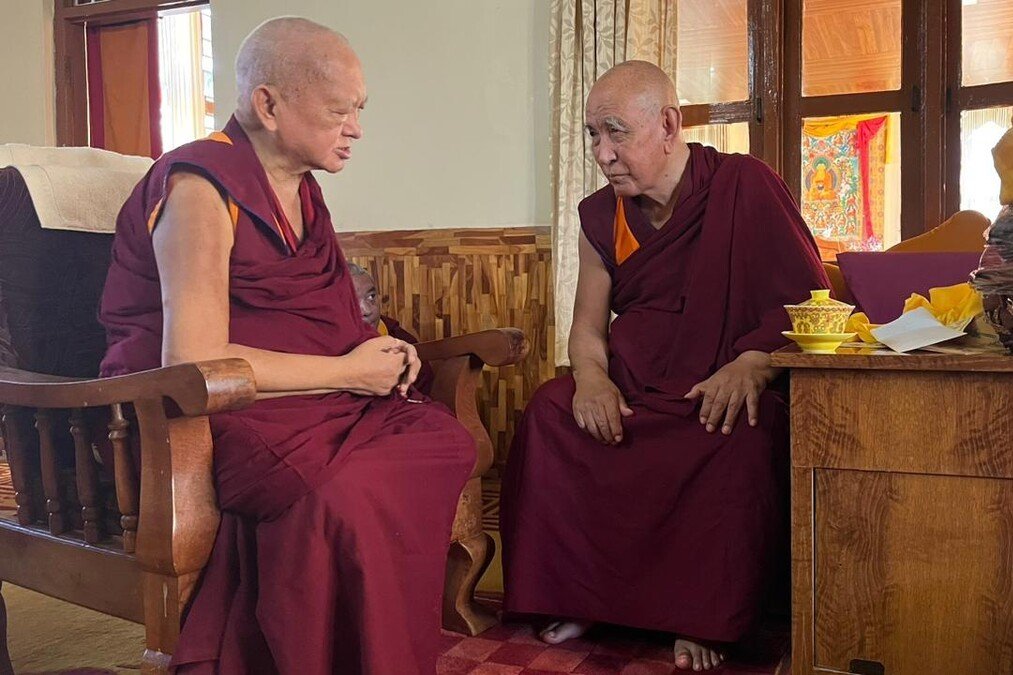
Lama Zopa Rinpoche meeting with the 104th Ganden Tripa, H.E. Lobsang Tenzin Rinpoche, September 21, 2022. Photo by Ven. Lhundrup Topgye.
Meeting with High Lamas and Monastery Leaders
During his trip to South India, Rinpoche met with a number of leaders and high lamas from the great monasteries in the region. On September 21, Rinpoche met with the current throne-holder of the Gelug lineage, His Eminence the 104th Ganden Tripa Lobsang Tenzin Rinpoche. Earlier Rinpoche met with Sera Mey Abbott Khen Rinpoche Geshe Tashi Tsering, the former longtime resident teacher at FPMT-affiliate Jamyang Buddhist Centre in London, England. On September 23, Rinpoche visited with Khenchen Pema Sherab from Namdroling Monastery.
Later that week Rinpoche visited with the abbot and manager of Gyudmed Tantric College. Rinpoche then met with Geshe Drugdra from Gyudmed, a teacher whom Rinpoche has received oral transmissions from recently.
In October, Rinpoche met with the abbott of Tashi Lhunpo Monastery, Khen Rinpoche Tehor Zeekgyab Tulku, and on another occasion, Oser Rinpoche. Rinpoche also had visits with the present reincarnations of three of his teachers, Choden Rinpoche, Domo Geshe Rinpoche, and the current tulku of Ribur Rinpoche.
Please Rejoice
Join us in rejoicing in all of these incredible activities, teachings, important meetings, and opportunities Rinpoche has created to benefit beings continuously and in the most expansive ways possible.
We invite you to see more photos of Rinpoche in our Singapore & India July–September 2022 photo album:
Lama Zopa Rinpoche is the spiritual director of the Foundation for the Preservation of Mahayana Tradition (FPMT), a Tibetan Buddhist organization dedicated to the transmission of the Mahayana Buddhist tradition and values worldwide through teaching, meditation and community service.
- Tagged: essential extracts podcast, kopan monastery, lama zopa rinpoche, lama zopa rinpoche activities, singapore
18
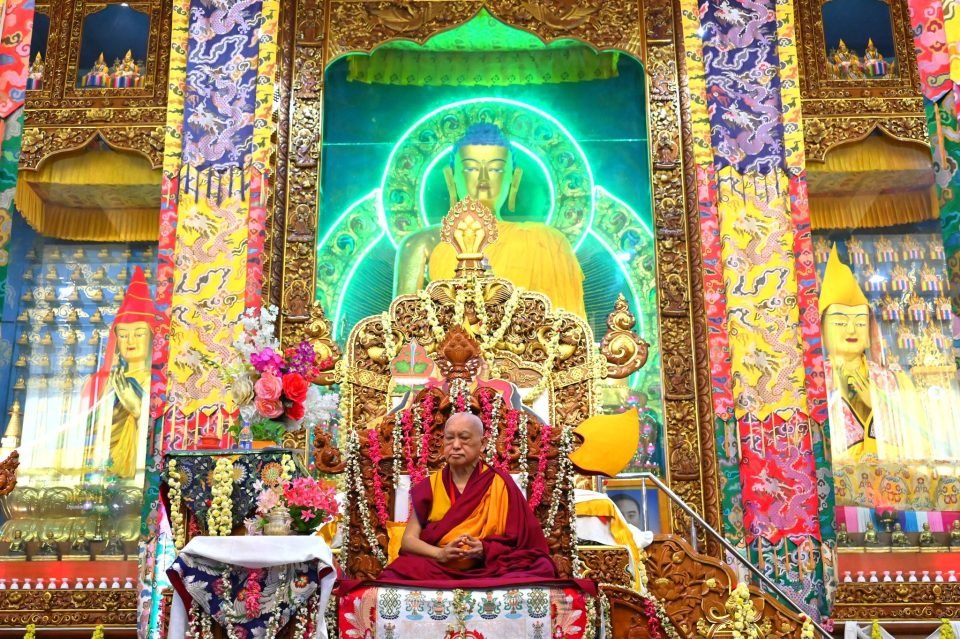
Lama Zopa Rinpoche during the long life puja offered by Sera Je Monastery, Bylakuppe, India, October 14, 2022. Photo Courtesy of Sera Je Monastery Facebook page.
On October 14, a long life puja and “Gratitude Award” was offered to Lama Zopa Rinpoche at Sera Je Monastery. This special event was to honor Rinpoche for the many decades of support Rinpoche has shown to the monastery, including the 25+ year accomplishment of the Sera Je Food Fund, which is now a full endowment covering the monastery’s yearly food expenses for over 2,000 Sangha.
Sera Je monk Ven. Tenzin Legtsok, shares the moving show of support to Rinpoche:
“This was a rare occasion when literally all of the monks of Sera Je came together from the youngest school boys up to the ex-abbots, the most senior monks from Buxa, all the geshes, tulkus, geshe program students, and monastery staff. Among the eminent lamas in attendance were the two former abbots of Sera Je, Khensur Rinpoche Lobsang Delek and Logoan Tulku Tenzin Choesang, the ex-abbot of Namgyal Monastery, Jhado Rinpoche, the current abbot of Sera Mey Monastery, Geshe Tashi Tsering, the abbot in waiting of Gyume Monastery, Geshe Ngawang Sangye and others. There were also representatives from the local Tibetan government. Everyone was there. Just the presence of so many monks was a powerful and palpable expression of their sincere respect for Rinpoche and their deep gratitude for His support over so many years. Every monk I spoke to was very happy that the monastery had decided to organize this long life puja and award ceremony for Rinpoche. Inside, the prayer hall was filled to overflowing with geshes and senior monks in the late years of the Geshe Studies Program such that the younger monks and school boys all had to sit outside.”

Lama Zopa Rinpoche arriving to Sera Je Monastery before the long life puja, Bylakuppe, India, October 14, 2022. Photo Courtesy of Sera Je Monastery Facebook page.
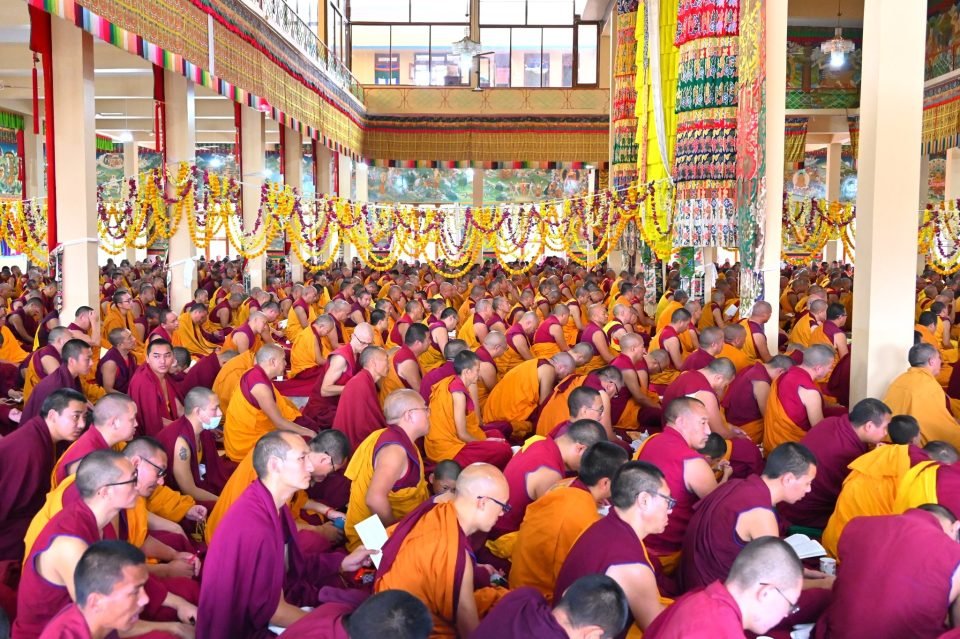
Sangha of Sera Je Monastery offering a long life puja to Lama Zopa Rinpoche, Bylakuppe, India, October 14, 2022. Photo Courtesy of Sera Je Monastery Facebook page.
The proceedings began with an hour of opening prayers, followed by processions of mandala offerings made by leaders of the monastery and each khangtsen (monastic community house), as well as the monastery school, healthcare center, and library. The Sangha of Sera Je then made extensive auspicious offerings, completing with the main mandala offering to Rinpoche coming from Sera Je abbot Geshe Tashi Tsethar. The abbot’s words to Rinpoche are recounted here by Ven. Legtsok:
“He began by recounting how difficult the situation was for the monks before Rinpoche began offering food. Money was extremely scarce and most monks struggled to get enough food to eat. As a result, many came down with illnesses or left. Seeing that this situation was a source of much suffering and a hindrance to the development of the monastic community, Khensur Rinpoche Lobsang Tsering requested Rinpoche to help sponsor food for the monks. That was thirty-one years ago. Since then, Rinpoche has continually provided funding for three meals per day enabling the monastic community to thrive.
“The abbot recounted how, wishing to ensure that the monks were provided with food far into the future Rinpoche endeavored on the monumental task to build up an endowment such that the cost of food would be covered by the interest from this fund. In 2017 FPMT offered this endowment of US$5.3 million. Again and again the abbot said that to express all of Rinpoche’s holy deeds would be impossible and totally beyond him. But to mention a few more he recounted Rinpoche’s support for building the current prayer hall when the old one had been outgrown, Rinpoche’s support over many years for the Sera Je School, for the healthcare center, the library, for the many khangtsens and private house groups, for other monasteries belonging to both the Geluk, Sakya, Nyingma, and Kagyu Traditions, as well as for schools, clinics, homes for the elderly and more in the Tibetan exile community as well as Nepal and India, not to mention building countless holy objects.
“The abbot expressed how this immense work of generosity was not Rinpoche’s alone but has also been the work of Venerable Roger Kunsang, other FPMT International office staff, sponsors, and the hundred-fifty plus FPMT centers, projects, and all the benefactors and students. As the abbot spoke all were silent and one could feel the energy of gratitude build as the monks took to mind all that Rinpoche and FPMT have done for them and countless others. Voicing one kindness after another and looking out at the sea of geshes and monks in their yellow robes that Rinpoche’s generosity has enabled to grow so large, the abbot teared up and had to pause for a few moments to collect himself. So sincere was his deep appreciation.”
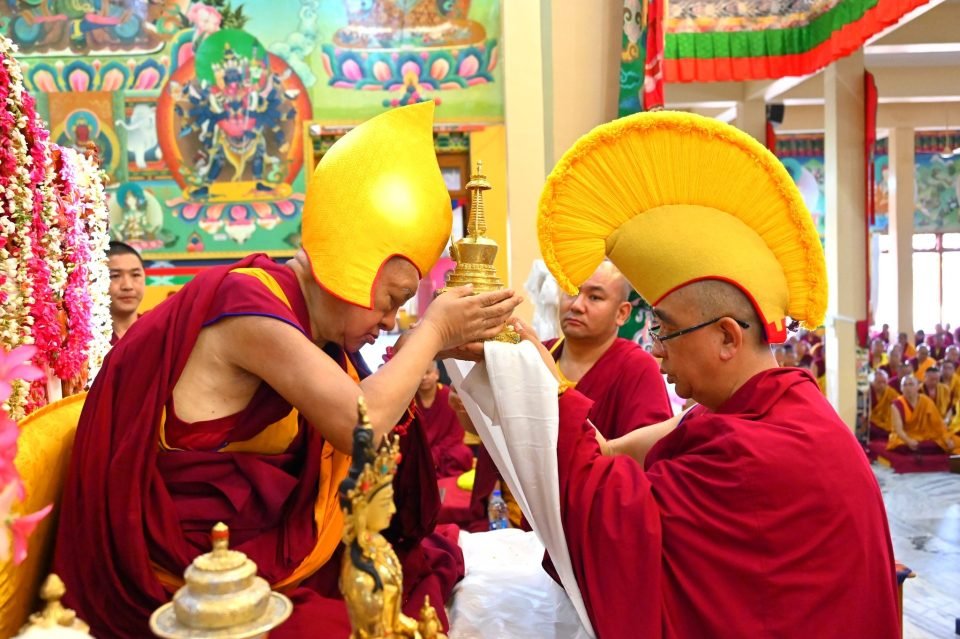
Lama Zopa Rinpoche receiving a stupa during long life puja offered by Sera Je Monstery, Bylakuppe, India, October 14, 2022. Photo courtesy Sera Je Monastery Facebook page.
The long life puja spanned over four hours, at the end of which Lama Zopa Rinpoche offered words of humility and then requested to informally share some advice. Ven. Legtsok summarizes some of Rinpoche’s words:
“The most important thing in studying in the monastery, Rinpoche said, was for it not to remain mere words but that it be accompanied by sincere practice. The essence of practice is to subdue the mind. To transform the mind into Dharma. If we do not subdue our minds and transform our actions into Dharma then the whole thing becomes a waste, another worldly endeavor with no benefit for ourselves or others.”
Rinpoche then offered further advice on methods to subdue the mind. The events concluded with the monastery disciplinarian offering a telling of Lama Zopa Rinpoche’s life story and thanking Rinpoche, Ven. Roger Kunsang, and all the FPMT staff, centers, teachers, students, benefactors, and all the organizers of the event.

Lama Zopa Rinpoche being presented “Expression of Gratitude” award during long life puja offered by Sera Je Monastery, Bylakuppe, India, October 14, 2022. Photo Courtesy of Sera Je Monastery Facebook page.
Awards Presented By the Monastery
The “Expression of Gratitude” award presented to Lama Zopa Rinpoche reads:
In honor of His Eminence Kyabje Lama Zopa Rinpoche’s immense contribution to the preservation and promotion not only within the Buddhist community domain but across the globe, disseminating the wisdom and knowledge of the Buddha Dharma. In particular, Rinpoche has remained the principal patron and benefactor of Sera Je Monastery through significant support to major projects and programs, such as the Assembly Hall, annual All Gelug Institute’s Winter Debate, known as ‘”Jang-Gun-Choe;” annual All Gelug University Board Examinations, and the Sera Je Food Fund since 1991.
This Expression of Gratitude is hereby presented to H.E. Kyabje Lama Zopa Rinpoche, in recognition and profound appreciation of His Infinite kindness and philanthropic support to Sera Je Monastery, and in continuing his numerous spiritual, educational, and social development mission projects and programs.
Ven. Roger Kunsang was also recognized at this ceremony for his decades-long devotion to Lama Zopa Rinpoche’s vision with a “Expression of Appreciation” award. The award plaque reads:
In honor of Venerable Roger Kunsang for his commendable and enduring service in the capacity of personal secretary to His Eminence Kyabje Lama Zopa Rinpoche and as CEO leading the FPMT, the centers, and its mission successfully over the years.
Sera Je Monastery has received immense contribution support from His Eminence Kyabje Lama Zopa Rinpoche through FPMT’s programs during the last three decades.
This Expression of Appreciation is hereby presented to Ven. Roger Kunsang, in recognition and profound appreciation for his commitment and devotional service to His Eminence Kyabje Lama Zopa Rinpoche and leading the FPMT successfully and particularly in the preservation and promotion of the Buddha Dharma and also towards social developmental welfare of communities and institutions.
Please join the entire FPMT community in rejoicing at this sincere offering of gratitude and well wishes for the long and healthy life of Lama Zopa Rinpoche from the Sera Je Monastery community on behalf of all who Rinpoche has been benefitting in so many numerous and expansive ways; and for acknowledging the tireless devotion and service of Ven. Roger Kunsang.
Lama Zopa Rinpoche is the spiritual director of the Foundation for the Preservation of Mahayana Tradition (FPMT), a Tibetan Buddhist organization dedicated to the transmission of the Mahayana Buddhist tradition and values worldwide through teaching, meditation and community service.
12
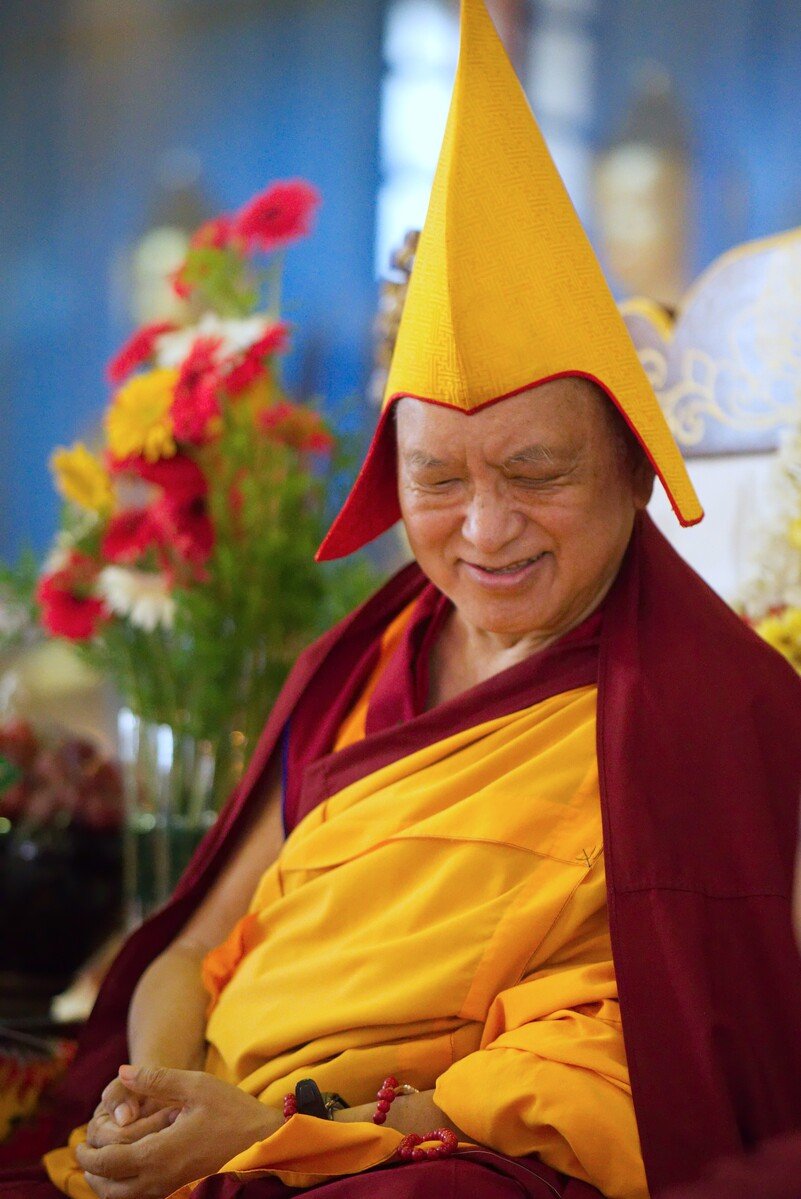
Lama Zopa Rinpoche during a long life puja offered to him at Sera Je Monastery, Byalakuppe, India, November 2017. Photo by Ven. Lobsang Sherab.
Sera Je Monastery is offering a long-life puja for Lama Zopa Rinpoche on October 14 at the Main Prayer Hall in the monastery, and presenting Rinpoche with a special “Gratitude Award” for the many decades of support Rinpoche has shown to the monastery, including the 25+ year accomplishment of the Sera Je Food Fund, which is now a full endowment covering the monastery’s yearly food expenses for over 2,000 Sangha.
All are welcome to join in this auspicious event on Facebook or through an English translation on Zoom (Meeting ID: 837 8829 0095).
We look forward to sharing photos and details from this special puja after the event.
Lama Zopa Rinpoche is the spiritual director of the Foundation for the Preservation of Mahayana Tradition (FPMT), a Tibetan Buddhist organization dedicated to the transmission of the Mahayana Buddhist tradition and values worldwide through teaching, meditation and community service.
18
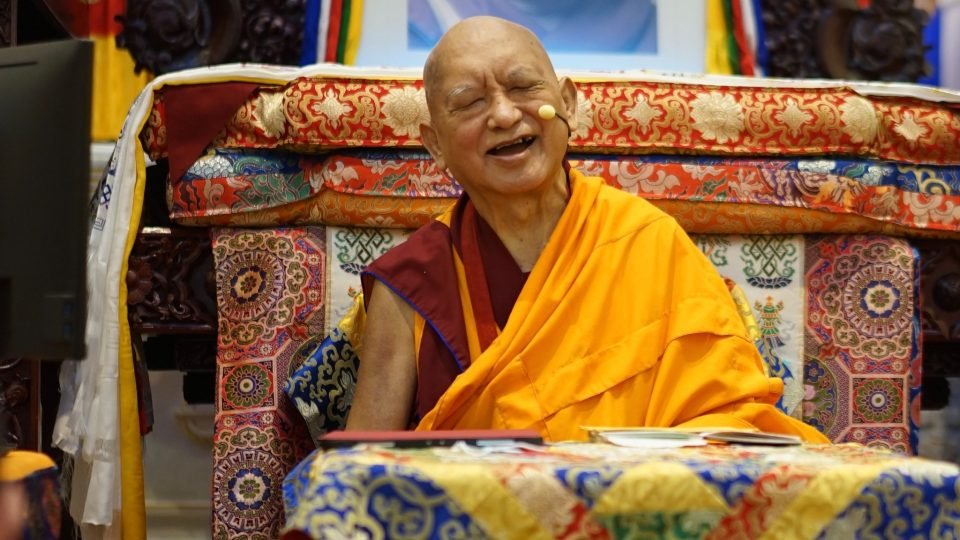
Lama Zopa Rinpoche teaching at Amitabha Buddhist Centre, Singapore, August 10, 2022. Photo courtesy of ABC.
Lama Zopa Rinpoche will begin offering a Five-Deity Heruka Initiation on August 19 and will continue through August 23 at Amitabha Buddhist Centre (ABC) in Singapore. The initiation is strictly for on-site participation by approved registrants only, and attendance at all sessions is required. However, Rinpoche’s motivation prior to the initiation will be livestreamed on Lama Zopa Rinpoche and FPMT’s Facebook pages and FPMT’s YouTube channel (with transcript and without transcript). The teachings are being translated in Chinese, Russian, Spanish and Italian. Some sessions will also be translated also to Indonesian, French, and Portuguese. For those needing translation, you can join via Zoom details which are on the Amitabha Buddhist Centre’s Facebook page. If you wish to listen to the teachings in English please listen on YouTube, as the Zoom session is limited to 1,000 viewers and we would like to ensure that all students who need translation will be able to get a seat.
We will also be offering the full-length videos, transcripts, and summaries of these teachings following the live events.
The schedule is as follows:
- August 19 (Fri) 7.30 p.m.
- August 20 (Sat) 4 p.m.
- Aug 21 (Sun) 4 p.m.
- Aug 22 (Mon) 7.30 p.m.
- Aug 23 (Tues) 7.30 p.m.
Please note that these online streams can be for any of the five sessions, starting with the session on August 19, and can be of any duration. Please keep a lookout for livestreaming around the time of the start of each session. Streaming will stop the moment Rinpoche goes into restricted parts of the initiation.If you are in Singapore and wish to participate in the Five-Deity Initiation onsite at ABC, please refer to the prerequisites and lifetime practice commitments.
Lama Zopa Rinpoche is the spiritual director of the Foundation for the Preservation of Mahayana Tradition (FPMT), a Tibetan Buddhist organization dedicated to the transmission of the Mahayana Buddhist tradition and values worldwide through teaching, meditation and community service.
11

Lama Zopa Rinpoche teaching at Amitabha Buddhist Centre, Singapore, August 2022. Photo courtesy of ABC Facebook page.
Lama Zopa Rinpoche has been offering very precious teachings on thought transformation and lamrim from Amitabha Buddhist Centre (ABC), Singapore. Teachings started on August 1 and will continue for the whole month. The teachings on thought transformation have been given to students in Russia and are a continuation of the teachings given from Kopan Monastery on June 25 and June 26 and also are part of the ongoing thought transformation series of teachings which Rinpoche began in 2020.
All are welcome to join live online from anywhere in the world. These teachings are being livestreamed on Lama Zopa Rinpoche and FPMT’s Facebook pages and FPMT’s YouTube channel (with transcript and without transcript).
The teachings are being translated in Chinese, Russian, Spanish and Italian. Some sessions will also be translated also to Indonesian, French, and Portuguese. For those needing translation, you can join via Zoom details which are on the ABC Facebook page.
If you wish to listen to the teachings in English please listen on YouTube, as the Zoom session is limited to 1,000 viewers and we would like to ensure that all students who need translation will be able to get a seat.
We will also be offering the full-length videos, transcripts, and summaries of these teachings following the live events.
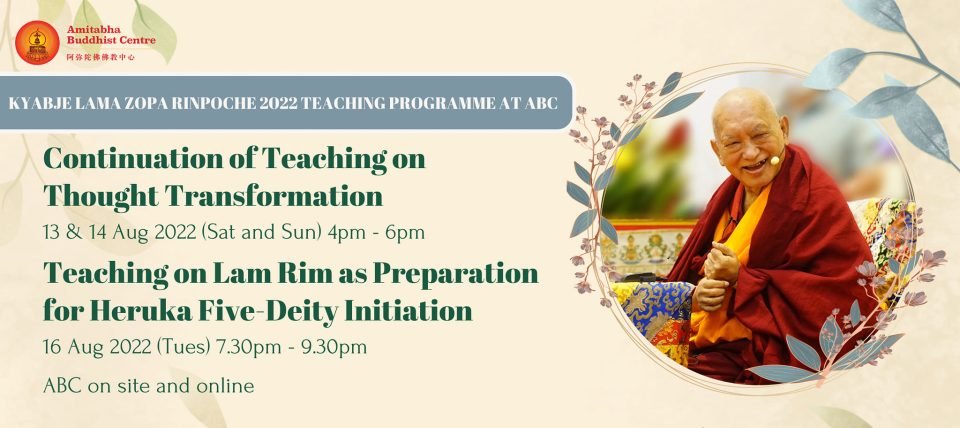
- Learn how to GET NOTIFIED when a stream starts.
Lama Zopa Rinpoche is the spiritual director of the Foundation for the Preservation of Mahayana Tradition (FPMT), a Tibetan Buddhist organization dedicated to the transmission of the Mahayana Buddhist tradition and values worldwide through teaching, meditation and community service.
1
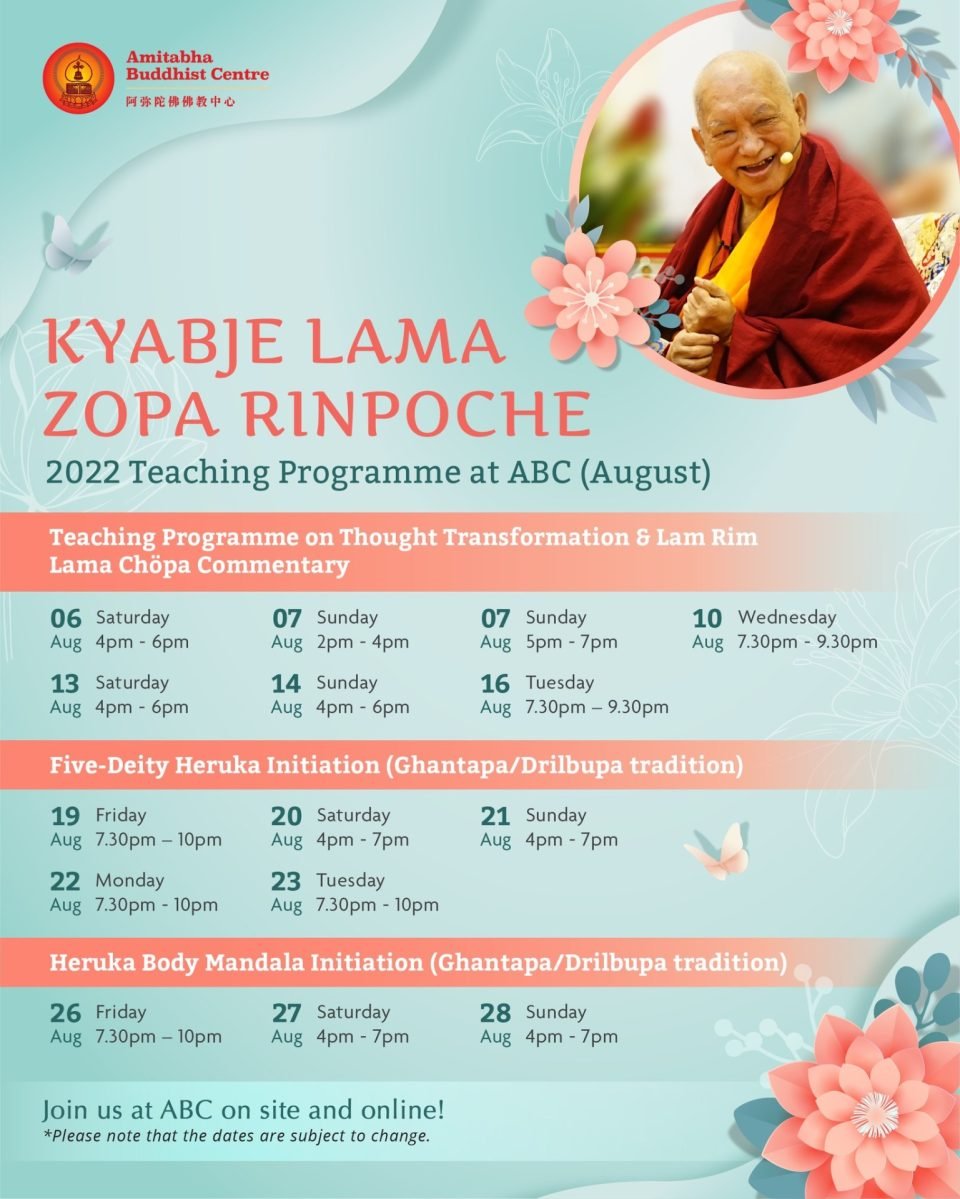
Lama Zopa Rinpoche’s August Program
August 6-16, 2022: Teachings on thought transformation, lamrim, and Lama Chöpa commentary. These teachings, including the initial sessions of the Lama Chöpa commentary, will be open to all without any prerequisites, and will also be streamed live on FPMT Facebook and YouTube.
August 19-23: Five-Deity Heruka Initiation. Available onsite at ABC only.
August 26-28: Heruka Body Mandala Initiation. Available onsite at ABC only.
Information about registration, prerequisites, practice commitments, and other information can be found on ABC’s recent newsletter. Specific times of teachings are listed on the flyer above, and please do note that the times are listed according to local time in Singapore.
Watching the Livestream of the August 6-16 Teachings:
Please subscribe to the FPMT YouTube channel to get notified when the stream starts.
- Read how to GET NOTIFIED when a stream starts.
- Pour savoir comment recevoir une notification quand le live commence, cliquez ici.
- Para saber como recibir una notificación cuando comienza la transmisón, pulsa aquí.
- Leggi come ESSERE INFORMATO quando comincia la diretta streaming.
Lama Zopa Rinpoche is the spiritual director of the Foundation for the Preservation of Mahayana Tradition (FPMT), a Tibetan Buddhist organization dedicated to the transmission of the Mahayana Buddhist tradition and values worldwide through teaching, meditation and community service.
15
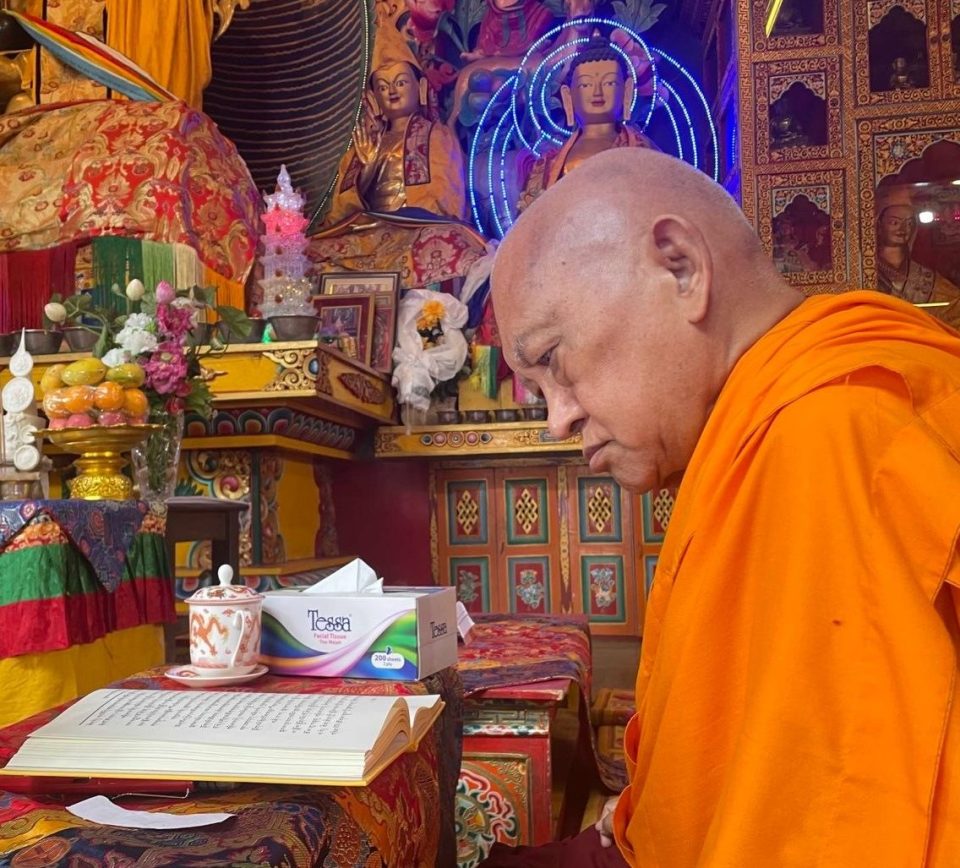
Rinpoche receiving the oral transmissions from Geshe Thupten Rinchen, April 23, 2022. Photo by Ven. Thubten Tendar.
Since our last update, Lama Zopa Rinpoche has remained in Nepal before traveling to Singapore for a simple medical procedure, engaging in a variety of auspicious activities, including maximizing every moment of merit-multiplying Saka Dawa and continuing to offer teachings to a variety of audiences. Rinpoche ordained new Sangha at Kopan Monastery in May, offered a mandala at the inauguration of a new building for the Nepal Buddhist Gelug Association on June 8, and visited the Karuna Hospital on June 21 offering advice on death and dying to the staff. Rinpoche met with Telo Rinpoche at Kopan May 9 and with the incarnation of Trulshik Rinpoche on May 16.
We invite you to read more about some of these activities below and to join us in rejoicing in the compassionate service Rinpoche offers every day, inspiring us all to live a full and beneficial life.
Rinpoche’s Health Update

Most Secret Hayagriva tsog kong offered to Lama Zopa Rinpoche for his long life, Kopan Monastery, Nepal, June 24, 2022.
Earlier this month, Rinpoche traveled to Singapore for a simple medical procedure. Rinpoche is recovering well from this procedure and students around the world participated in the advice given by Khandro Kunga Bhuma for Rinpoche’s health at this time. We also invite you to rejoice in the various practices that have been done and planned for Rinpoche’s health this year:
- A White Tara long life puja was offered on March 11, 2022, at Kopan Monastery. This special long life puja involved seven days of preparation led by Khandro-la with the Kopan monks.
- In March, Khandro-la advised that students recite Chenrezig and White Tara mantras for His Holiness the Dalai Lama and Lama Zopa Rinpoche’s health, for the fulfilment of all their wishes, and for the benefit of all in the FPMT organization. Incredibly, during the most meritorious period from Losar up to and including the last of the Days of Miracles, Chotrul Duchen, a total of 12,719,479 mani mantras and 1,759,396 White Tara mantras were offered by FPMT students and centers around the world.
- In May, Khandro-la advised FPMT students to recite refuge and bodhicitta prayers, and FPMT students and centers around the world have been offering these prayers.
- An all-day Most Secret Hayagriva tsog kong, was offered by the Kopan Lama Gyupas and senior monks and nuns of Kopan on June 24, 2022.
- 17,417 pounds of cockles were liberated for Rinpoche’s health by Ven. Drachom at Amitabha Buddhist Centre, Singapore.
- Three separate long life deity thangkas were painted and consecrated in one day in July 2022.
- Painting for the three main stupas in Kathmandu was offered in July 2022.
- One horse and ten sheep were liberated in Mongolia in July 2022.
- Lama Chopa long life puja will be offered at Kopan Monastery at the end of the November lamrim course.
- Guru Rinpoche bum tsog and raising of the great thangka of Guru Rinpoche at Kopan Nunnery will happen at the end of 2022.
Teachings
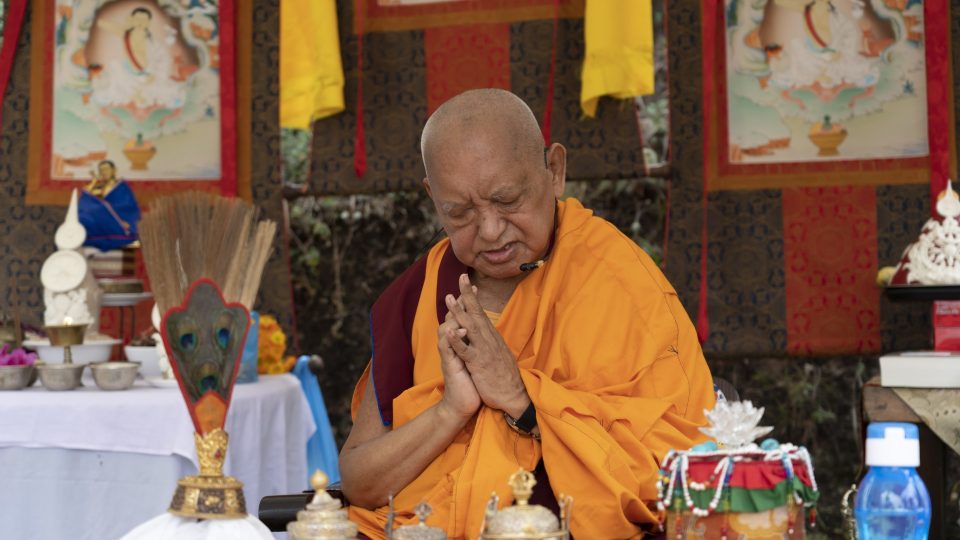
Lama Zopa Rinpoche offering Milarepa initiation, April 6, 2022. Photo by Ven. Lobsang Sherab.
On April 6 Rinpoche offered a Milarepa initiation and teachings to a small group of senior Kopan monks, senior Khachoe Ghakyil Ling nuns, Western sangha, and some lay students. We invite you to watch the teaching that Lama Zopa Rinpoche offered prior to the initiation. A full transcript of this teaching is also available.
Rinpoche gave four teachings to students attending the 2022 Vajrasattva retreat at Kopan Monastery: an introductory teaching on March 30 and three subsequent teachings on April 26–28. You can find all the videos and a combined transcript of these teachings on our page “Teachings for 2022 Vajrasattva Retreatants at Kopan Monastery.
In May the Lama Zopa Rinpoche Essential Extracts Podcast was launched. This podcast captures the essence of Rinpoche’s teachings and each fifteen-to thirty-minute episode is edited and condensed from a longer teaching by Rinpoche and focuses on a single topic. New episodes are released every other Monday and previously published episodes are available as well.
Rinpoche continued offering teachings on refuge to a group of Chinese students via Zoom from Kopan Monastery in June and we will offer these teachings on video with transcripts as soon as they become available.
Rinpoche offered two teachings to Russian students via Zoom from Kopan Monastery at the end of June and we will offer these teachings on video with transcripts as soon as they become available. A third teaching is planned for this group and Rinpoche has indicated that these are complimentary to and a condensed teaching on the thought transformation series that Rinpoche has been giving for the last two and a half years.
Following Rinpoche’s discharge from the hospital in Singapore for the medical procedure, Rinpoche joined the Amitabha Buddhist Centre (ABC) community in Singapore for their special celebration of His Holiness the Dalai Lama’s 87th birthday with puja. Prior to the puja Rinpoche shared, “So thank you very much. Due to all your prayers I’m feeling better. The operation was like a short sleep. I fell asleep, then finished! It was very efficient.”
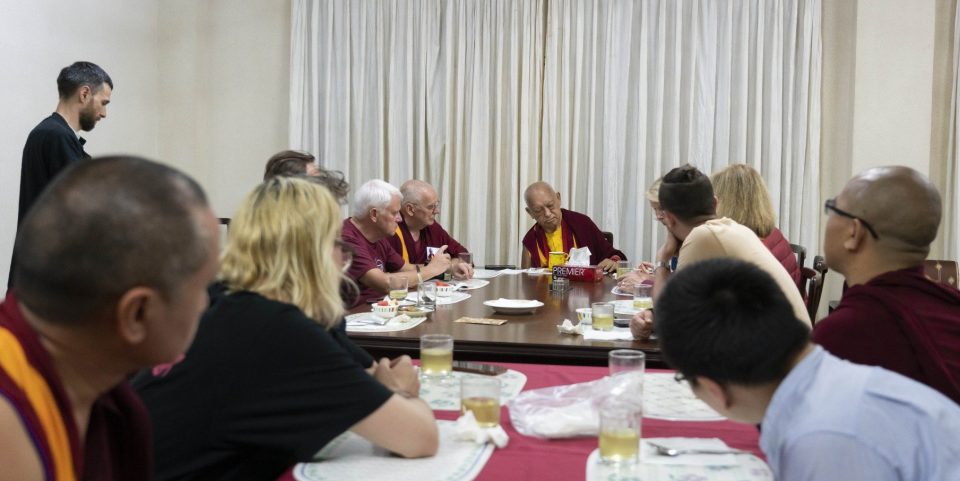
Lama Zopa Rinpoche meeting Russian neuroscientists at Kopan Monastery, Nepal, May 2022. Photo by Ven. Lobsang Sherab.
Scientists Studying Meditation
A group of Russian neuroscientists spent time at Kopan Monastery conducting studies on the monks with respect to meditation and brain waves. Rinpoche met and spoke with them as well. We will be sharing details about this interesting study very soon!
Geshe Thubten Rinchen Lungs
Rinpoche had requested precious oral transmissions (lungs) from Geshe Thubten Rinchen—a great hidden yogi and the main teacher of Sera Mey and Tashi Lhunpo monasteries—several times for the benefit of the Kopan community. From April 15—May 9, 2022, Geshe Rinchen fulfilled Rinpoche’s request and several hundred Kopan monks and nuns, as well as a few others from various locations, received the lungs which were a transmission of parts of the five great texts that are the curriculum of Sera Je Monastery and some of the other great monasteries. You can read more about these lungs.
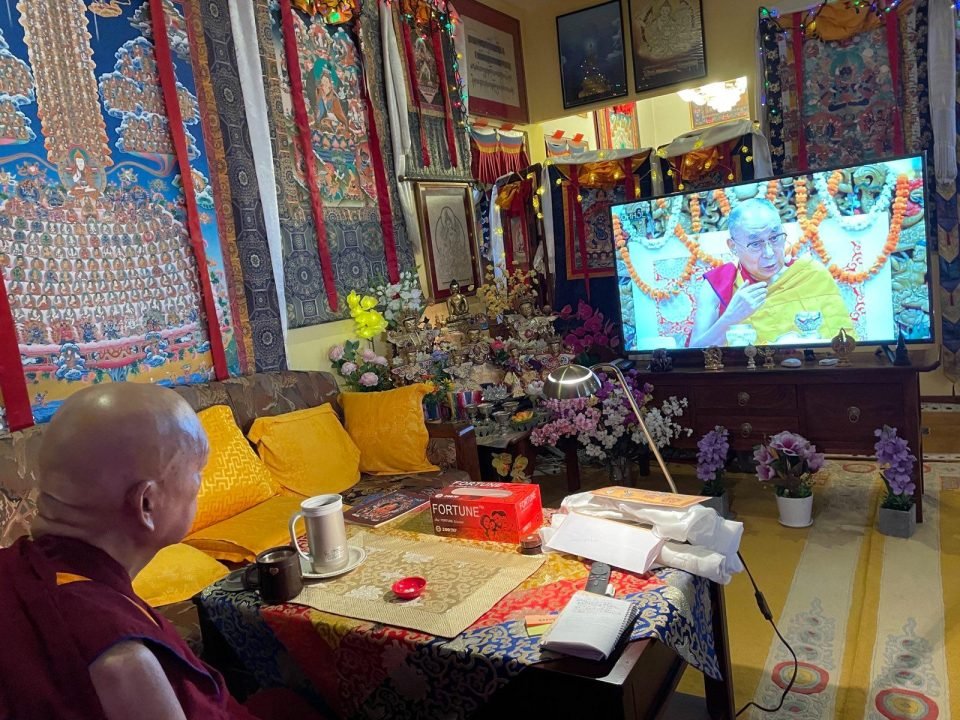
Lama Zopa Rinpoche watching His Holiness the Dalai Lama’s teachings on Saka Dawa, June 14, 2022. Photo by Ven. Lobsang Sherab.
Saka Dawa
On the merit-multiplying day of Saka Dawa, celebrated on June 13 this year, Rinpoche filled every moment with the opportunity to be as beneficial as possible. He attended a teaching with His Holiness via Zoom, attended tsog at Namgyal Jyangchub Choeling Monastery, turning two prayer wheels at once, with 3 trillion mantras in each. He also blessed water and Vaseline with mantras, for those who are sick and continued writing out the Prajnaparamita sutra late into the night.
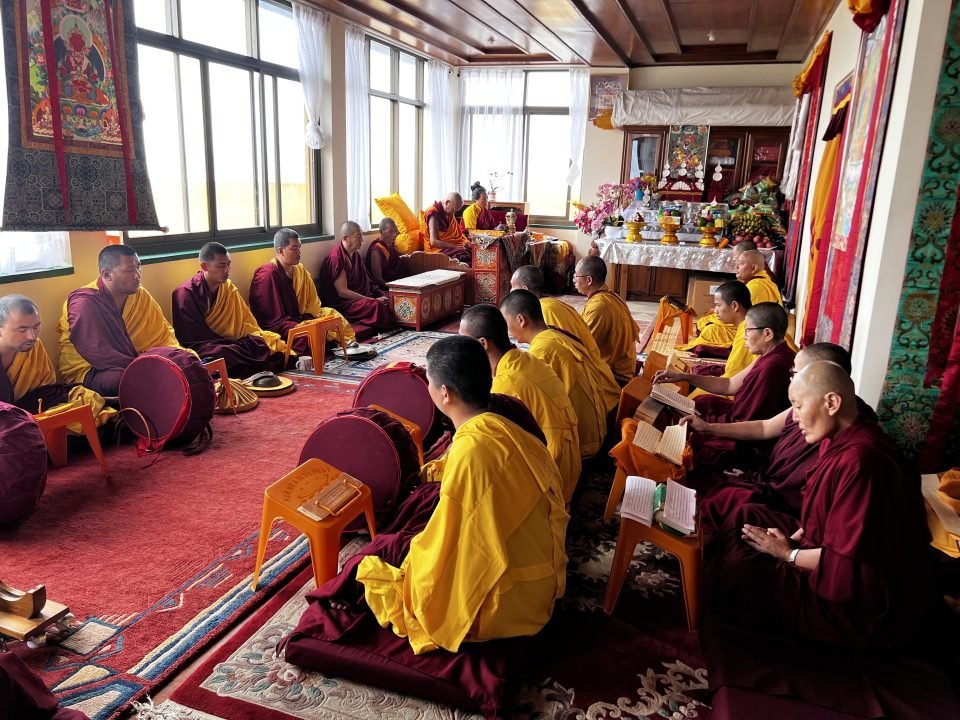
Lama Zopa Rinpoche, Khandro-la, and Kopan Sangha doing Palden Lhamo puja at Kopan Monastery, May 30, 2022. Photo by Ven. Roger Kunsang.
Circumambulating the Kopan Monastery Altar, Boudha Stupa, Swayambhunath
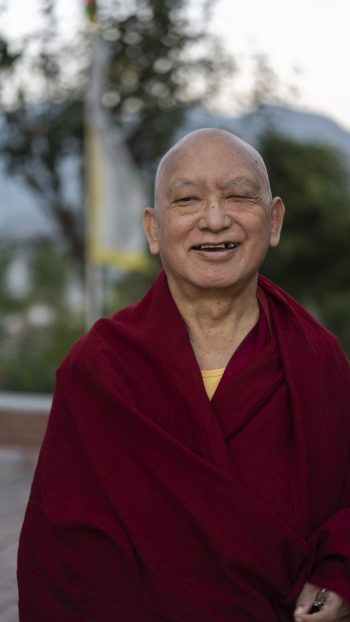
Lama Zopa Rinpoche circumambulating the stupa at Kopan Monastery. Photo by Ven. Lobsang Sherab.
Often Rinpoche circumambulates six times, dedicating each circuit to each of the six realms. Rinpoche also has explained this essential advice when circumambulating: Visualize that all the numberless buddhas, Dharma, and Sangha in the ten directions are in front of you in the form of the stupa as well every single holy object—statue, stupa, scripture, relic, etc.—that exists in every universe anywhere and think that all of these are your root guru integrated into one. You can also visualize the stupa taking the form of the Guru Puja merit field, or a deity such as Chenrezig or Vajrasattva, with the awareness that this is your root guru. The most important thing, Rinpoche stresses, is to always keep the mind in devotion seeing all the holy objects you are circumambulating as a manifestation of your root guru. This is the most skillful meditation for the purification to become most powerful and to collect the most extensive merit. It’s the same meditation whether you are circumambulating a stupa or in your shrine room.
Pujas and Practices
Rinpoche participated in many pujas and practices with others including:
- Yamantaka sadhana recitation with Kopan Lama Gyupas and Geshe Rinchen for the benefit of all beings and to remove all obstacles.
- Tara puja at the special Tara Temple in Kathmandu in April with Geshe Tenzin Zopa, Geshe Thubten Sherab, and the Kopan monks and nuns.
- Lama Chopa Tsog was completed several times at Kopan Monastery and Khachoe Ghakyil Nunnery.
- Palden Lhamo Puja was done with Khandro-la and Kopan Sangha twice in May
- Lama Chopa Puja was done on the occasion of Khyongla Rato Rinpoche passing away on May 24.
We invite you to see more photos of Rinpoche in our April–June 2022 photo album:
https://fpmt.org/teachers/zopa/gallery/nepal-april-june-2022/
Lama Zopa Rinpoche is the spiritual director of the Foundation for the Preservation of Mahayana Tradition (FPMT), a Tibetan Buddhist organization dedicated to the transmission of the Mahayana Buddhist tradition and values worldwide through teaching, meditation and community service.
- Tagged: essential extracts podcast, kopan monaster, lama zopa rinpoche, lama zopa rinpoche activities, singapore
6
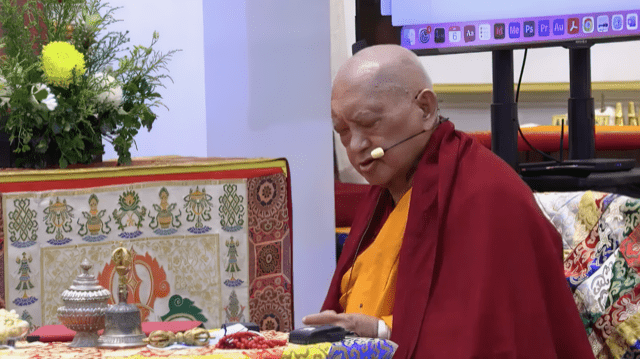
Lama Zopa Rinpoche joined the ABC community in Singapore for a special birthday celebration and puja for His Holiness the Dalai Lama, following Rinpoche’s discharge from the hospital for a simple medical procedure, July 6, 2022.
On Friday we shared the news that Lama Zopa Rinpoche was in Singapore for a simple medical procedure, and Khandro Kunga Bhuma (Khandro-la) advised on particular practices for students to engage in at this time and for a period following the procedure.
We are delighted to share Ven. Roger Kunsang’s most recent update from today:
This morning Rinpoche was discharged from the hospital here in Singapore. The doctor was very pleased with the results of the procedure.
Rinpoche says he is feeling very well and a little bit lighter!
Sincerely,
roger
Following his discharge from the hospital Rinpoche joined the Amitabha Buddhist Centre (ABC) community in Singapore for their special celebration of His Holiness the Dalai Lama’s 87th birthday with puja. Prior to the puja, Rinpoche talked with the group and offered a short teaching. Rinpoche shared, “So thank you very much. Due to all your prayers I’m feeling better. The operation was like a short sleep. I fell asleep, then finished! It was very efficient.”
All are welcome to watch this event which was livestreamed:
We encourage all students to please continue with the recommended prayers and practices advised by Khandro-la until July 15:
- Animal Liberations
Liberating Animals from the Danger of Death
Available from the FPMT Foundation Store: shop.fpmt.org/Liberating-Animals-from-the-Danger-of-Death-PDF_p_1115.html
- Tara Mantra and Tara Praises
Tara Praise and Mantras
Available from the FPMT Foundation Store: shop.fpmt.org/Tara-Praise-and-Mantras-PDF-_p_3582.html
Abbreviated Praise to the Twenty-one Taras
Available from the FPMT Foundation Store: shop.fpmt.org/Abbreviated-Praise-to-the-Twenty-One-Taras-PDF_p_3466.html
- Vajrasattva Mantra to be recited as much as possible
A Short Vajrasattva Meditation Purification with the Four Opponent Powers
Available from the FPMT Foundation Store: shop.fpmt.org/A-Short-Vajrasattva-Meditation-Purification-with-the-Four-Opponent-Powers-eBook-PDF_p_1223.html
- Padmasambhava Prayers
Recitations of The Prayer to Guru Rinpoche that Spontaneously Fulfills All Wishes (Sampa Lhundrupma)
Available for download: https://fpmt.app.box.com/s/d09kz5j5gzk1z0eggx8dr5hfaqt565lz
Recitations of The Supplication to Guru Rinpoche Clearing the Obstacles on the Path (Barchey Lamsel)
Available for download: https://fpmt.app.box.com/s/rmlbbci39tsyihe2lt00gf50iwuv8kxw
Students can also recite the long life prayer that Khandro Kunga Bhuma composed for Lama Zopa Rinpoche in 2016.
A complete list of the long life prayers for Lama Zopa Rinpoche is available to all.
Lama Zopa Rinpoche is the spiritual director of the Foundation for the Preservation of Mahayana Tradition (FPMT), a Tibetan Buddhist organization dedicated to the transmission of the Mahayana Buddhist tradition and values worldwide through teaching, meditation and community service.
Visit our Long Life Puja Fund page to learn more about the purpose of long life pujas and opportunities to offer support for them.
1

Lama Zopa Rinpoche at Kopan Monastery, May 2022. Photo by Ven. Lobsang Sherab.
Every year Ven. Roger Kunsang, on behalf of the FPMT organization, consults Khandro Kunga Bhuma to determine what practices should be done to help create the conditions for Lama Zopa Rinpoche to have a long life and good health for the coming year. Khandro-la also offers advice as necessary for Rinpoche’s health. Rinpoche is now in Singapore for a simple medical procedure and Ven. Roger has just shared some new advice from Khandro-la which all FPMT centers, projects, services, and students are being asked to engage in as soon as possible and to continue over the next two weeks for Rinpoche’s health:
Current Advice for Lama Zopa Rinpoche’s Health
- Animal Liberations
Liberating Animals from the Danger of Death
Available from the FPMT Foundation Store: shop.fpmt.org/Liberating-Animals-from-the-Danger-of-Death-PDF_p_1115.html
- Tara Mantra and Tara Praises
Tara Praise and Mantras
Available from the FPMT Foundation Store: shop.fpmt.org/Tara-Praise-and-Mantras-PDF-_p_3582.html
Abbreviated Praise to the Twenty-one Taras
Available from the FPMT Foundation Store: shop.fpmt.org/Abbreviated-Praise-to-the-Twenty-One-Taras-PDF_p_3466.html
- Vajrasattva Mantra to be recited as much as possible
A Short Vajrasattva Meditation Purification with the Four Opponent Powers
Available from the FPMT Foundation Store: shop.fpmt.org/A-Short-Vajrasattva-Meditation-Purification-with-the-Four-Opponent-Powers-eBook-PDF_p_1223.html
- Padmasambhava Prayers
Recitations of The Prayer to Guru Rinpoche that Spontaneously Fulfills All Wishes (Sampa Lhundrupma)
Available for download: https://fpmt.app.box.com/s/d09kz5j5gzk1z0eggx8dr5hfaqt565lz
Recitations of The Supplication to Guru Rinpoche Clearing the Obstacles on the Path (Barchey Lamsel)
Available for download: https://fpmt.app.box.com/s/rmlbbci39tsyihe2lt00gf50iwuv8kxw
In addition, Ven. Roger reports that pujas are being arranged in monasteries and nunneries in India and Nepal for Rinpoche’s health at this time.
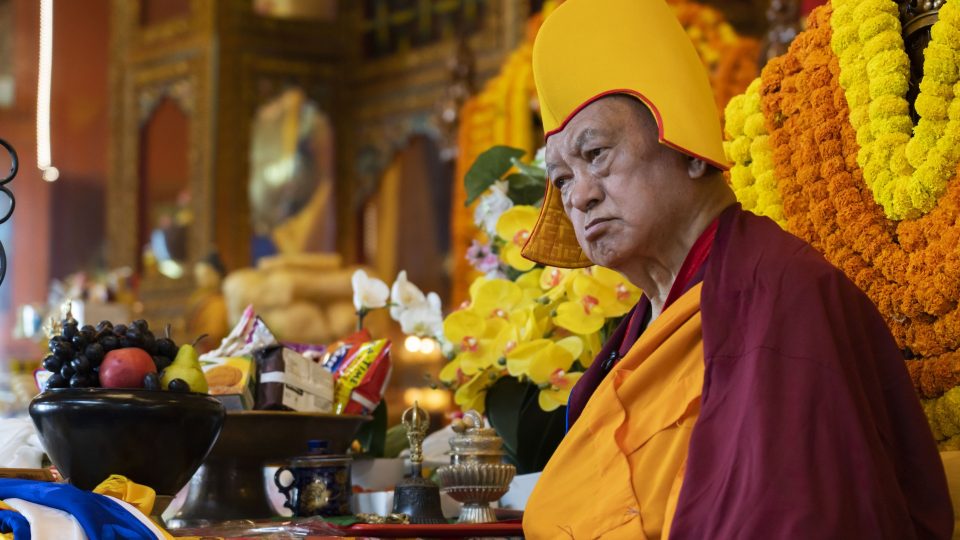
Lama Zopa Rinpoche during the long life puja offered to him, March 11, 2022, Kopan Monastery. Photo by Ven. Lobsang Sherab.
Completed and Planned Practices for Lama Zopa Rinpoche’s Health in 2022
We also ask you to join us in rejoicing in the following which has been completed and planned for Rinpoche as advised.
- A White Tara long life puja was offered on March 11, 2022, at Kopan Monastery. This special long life puja involved seven days of preparation led by Khandro-la with the Kopan monks.
- In March, Khandro-la advised that students recite Chenrezig and White Tara mantras for His Holiness the Dalai Lama and Lama Zopa Rinpoche’s health, for the fulfilment of all their wishes, and for the benefit of all in the FPMT organization. Incredibly, during the most meritorious period from Losar up to and including the last of the Days of Miracles, Chotrul Duchen, a total of 12,719,479 mani mantras and 1,759,396 White Tara mantras were offered by FPMT students and centers around the world.
- In May, Khandro-la advised FPMT students to recite refuge and bodhicitta prayers, and FPMT students and centers around the world have been offering these prayers.
- An all day Most Secret Hayagriva tsog kong, was offered by the Kopan Lama Gyupas and senior monks and nuns of Kopan on June 24, 2022.
- 17,417 pounds of cockles were liberated for Rinpoche’s health by Ven. Drachom at Amitabha Buddhist Centre, Singapore.
- Three long life deity thangkas will be painted and consecrated in one day in July 2022.
- Painting for the three main stupas in Kathmandu will be offered in July 2022.
- One horse and ten sheep will be liberated in Mongolia in July 2022.
- Lama Chopa long life puja will be offered at Kopan Monastery at the end of the November lamrim course.
- Guru Rinpoche bum tsog and raising of the great thangka of Guru Rinpoche at Kopan Nunnery will happen at the end of 2022.
Please join the entire FPMT community by engaging in these powerful advised practices for the long life and health of our most precious spiritual director, Lama Zopa Rinpoche.
Students can also recite the long life prayer that Khandro Kunga Bhuma composed for Lama Zopa Rinpoche in 2016.
A complete list of the long life prayers for Lama Zopa Rinpoche is available to all.
Lama Zopa Rinpoche is the spiritual director of the Foundation for the Preservation of Mahayana Tradition (FPMT), a Tibetan Buddhist organization dedicated to the transmission of the Mahayana Buddhist tradition and values worldwide through teaching, meditation and community service.
Visit our Long Life Puja Fund page to learn more about the purpose of long life pujas and opportunities to offer support for them.
- Tagged: lama zopa rinpoche long life, long life
18

Lama Zopa Rinpoche with Khandro Kunga Bhuma, Kopan Monastery, Nepal, March 2022. Photo by Ven. Roger Kunsang.
Every year FPMT CEO Ven. Roger Kunsang, on behalf of the FPMT organization, checks with Khandro-la (Khandro Kunga Bhuma) to determine what practices should be done to help create the conditions for FPMT’s Spiritual Director, Lama Zopa Rinpoche, to have a long life and good health for the coming year. In addition to the pujas and practices already advised, Khandro-la’s recent observation is that there are still obstacles to Rinpoche’s health.
Ven. Roger shared, “Khandro-la is therefore strongly advising students to continue to offer practices dedicated for Rinpoche’s good health, and now specifically to recite refuge and bodhicitta prayers. We sincerely request students to start this now or as soon as possible, and to continue over the coming two months. Individual students can offer this practice themselves, and we encourage centers to organize group practice sessions for this.”
We appreciate everyone’s swift engagement with these recommended prayers, dedicating strongly for Lama Zopa Rinpoche’s health and very long life.
Taking Refuge and Generating Bodhicitta
Sang gyä chhö dang tshog kyi chhog nam la
Jang chhub bar du dag ni kyab su chhi
Dag gi jin sog gyi päi tshog nam kyi
Dro la phän chhir sang gyä drub par shog
I take refuge until I am enlightened
In the Buddha, the Dharma, and the Supreme Assembly.
By my merits of generosity and so forth,
May I become a buddha to benefit transmigratory beings.
From FPMT Education Services’ Daily Prayers.
* Lama Zopa Rinpoche advised to replace sö nam (Tib. gsod rnams) in the third line with tshog nam (Tib. tshogs rnams), in accordance with His Holiness the Dalai Lama’s advice, and to translate tshog nam as “merits,” rather than “accumulation” or “collections.” Rinpoche explains that the two types of merits are the merits of virtue and the merits of wisdom, which are often translated as the “accumulation of merit” and the “accumulation of wisdom,” respectively.
Lama Zopa Rinpoche is the spiritual director of the Foundation for the Preservation of Mahayana Tradition (FPMT), a Tibetan Buddhist organization dedicated to the transmission of the Mahayana Buddhist tradition and values worldwide through teaching, meditation and community service.
For Lama Zopa Rinpoche’s explanation of the prayer for taking refuge and generating bodhicitta, students can follow the Living in the Path module “The Refuge and Bodhichitta Verse” (free, registration require). In it, Lama Zopa Rinpoche unpacks each word of these deceptively simple four lines to reveal their great profundity and tells us how to meditate on the whole path to enlightenment while reciting it.
The Long Life Puja Fund always contributes to long life pujas offered to Lama Zopa Rinpoche. You can also learn about the many Charitable Projects of FPMT and discover how the various funds and projects are benefiting others.
- Home
- News/Media
- Study & Practice
- About FPMT Education Services
- Latest News
- Programs
- New to Buddhism?
- Buddhist Mind Science: Activating Your Potential
- Heart Advice for Death and Dying
- Discovering Buddhism
- Living in the Path
- Exploring Buddhism
- FPMT Basic Program
- FPMT Masters Program
- FPMT In-Depth Meditation Training
- Maitripa College
- Lotsawa Rinchen Zangpo Translator Program
- Universal Education for Compassion & Wisdom
- Online Learning Center
- Prayers & Practice Materials
- Overview of Prayers & Practices
- Full Catalogue of Prayers & Practice Materials
- Explore Popular Topics
- Benefiting Animals
- Chenrezig Resources
- Death & Dying Resources
- Lama Chopa (Guru Puja)
- Lama Zopa Rinpoche: Compendium of Precious Instructions
- Lama Zopa Rinpoche: Life Practice Advice
- Lama Zopa Rinpoche Practice Series
- Lamrim Resources
- Mantras
- Prayer Book Updates
- Purification Practices
- Sutras
- Thought Transformation (Lojong)
- Audio Materials
- Dharma Dates – Tibetan Calendar
- Translation Services
- Publishing Services
- Teachings and Advice
- Find Teachings and Advice
- Lama Zopa Rinpoche Advice Page
- Lama Zopa Rinpoche: Compendium of Precious Instructions
- Lama Zopa Rinpoche Video Teachings
- ༧སྐྱབས་རྗེ་བཟོད་པ་རིན་པོ་ཆེ་མཆོག་ནས་སྩལ་བའི་བཀའ་སློབ་བརྙན་འཕྲིན།
- Podcasts
- Lama Yeshe Wisdom Archive
- Buddhism FAQ
- Dharma for Young People
- Resources on Holy Objects
- Ways to Offer Support
- Centers
- Affiliates Area
- Teachers
- Projects
- Charitable Projects
- Make a Donation
- Applying for Grants
- News about Projects
- Other Projects within FPMT
- Support International Office
- Projects Photo Galleries
- Give Where Most Needed
- FPMT
- Shop
Translate*
*powered by Google TranslateTranslation of pages on fpmt.org is performed by Google Translate, a third party service which FPMT has no control over. The service provides automated computer translations that are only an approximation of the websites' original content. The translations should not be considered exact and only used as a rough guide.Faith alone never stops problems; understanding knowledge-wisdom always does. Lord Buddha himself said that belief in Buddha was dangerous; that instead of just believing in something, people should use their minds to try to discover their own true nature.
Contact Info
Portland, OR 97214-4702 USA
Tel (503) 808-1588
About FPMT
Foundation for the Preservation of the Mahayana Tradition (FPMT) is an organization devoted to the transmission of the Mahayana Buddhist tradition and values worldwide through teaching, meditation and community service. more…






